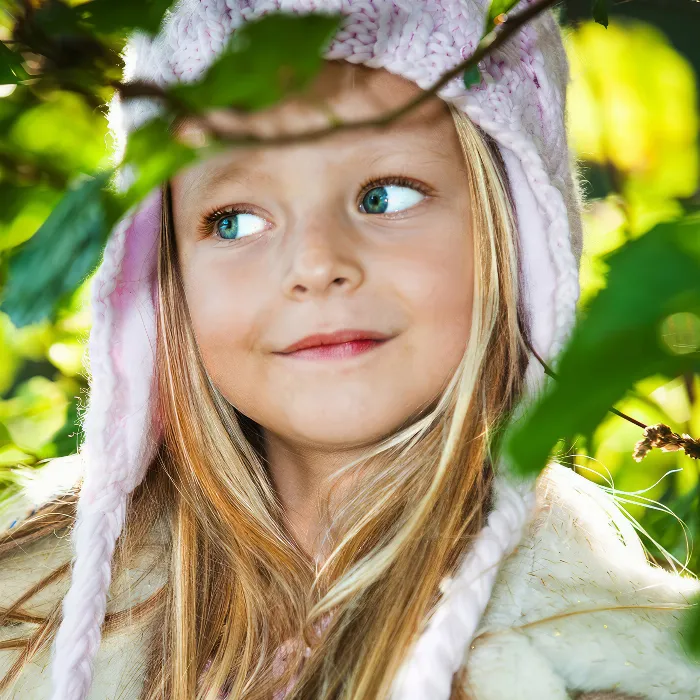Part 1: Introduction
Part 2: The right equipment
Part 3: The happy photo shoot
Part 4: From baby bump to teenager
Photos of the baby bump
Appointment question
In nature
In the studio
Newborns
At birth
The first days
Babies
Toddlers
Kindergarten age
School children
Teens and twens
Part 5: Indoor photography
Part 6: Outdoor photos
Part 7: Family life
Part 8: Tips and tricks (I)
Part 9: Tips and tricks (II)
Part 10: Archiving, editing and presenting children's photos
Text: Jens Brüggemann
Photos created by: Jens Brüggemann (147), Leonie Ebbert (44), Elli Bezensek (61), Radmila Kerl (26), Ramona Prosch (5), Kay Johannsen (4)
Sketches: Jens Brüggemann (27)
Part 4: From baby bump to teenager
Every learning process, every overcoming of the many hurdles that people face from foetus to adulthood serves one sole purpose: to no longer need their parents, to become independent. If we parents weren't so proud, we'd be crying all the time at the progress our little ones are making ...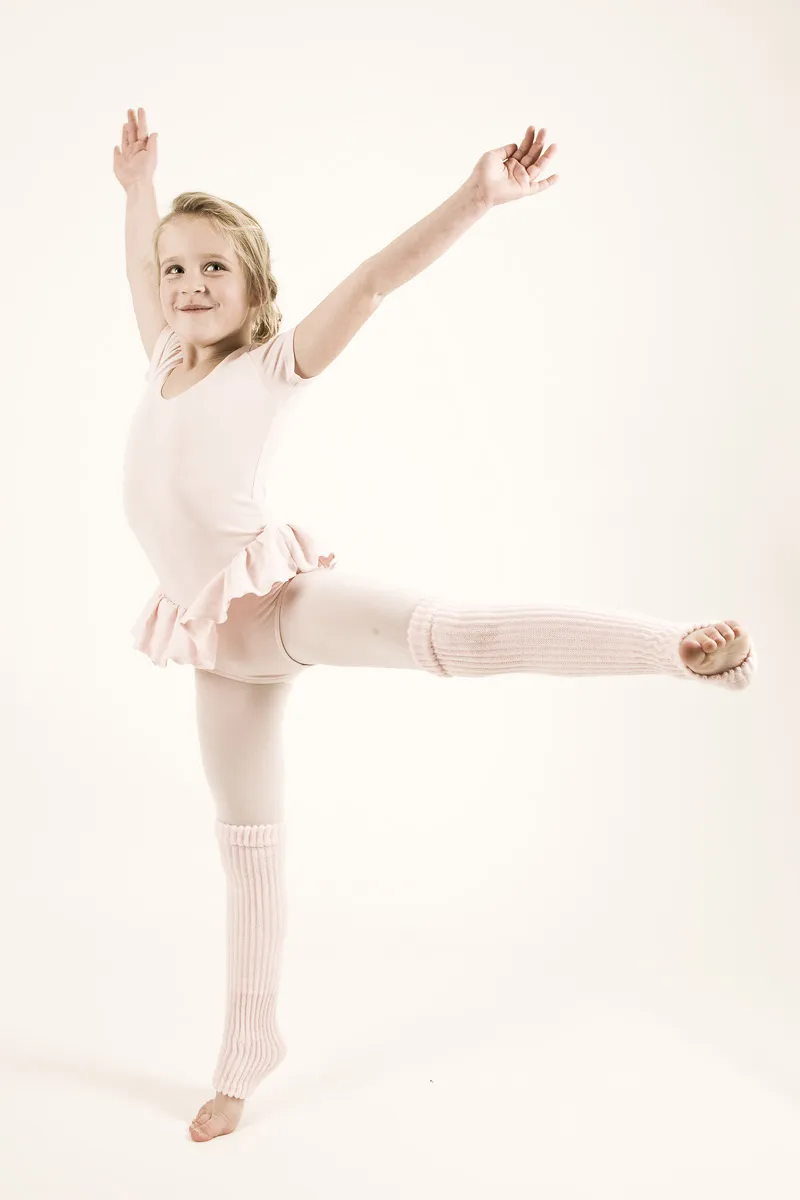
(Photo: Elli Bezensek)
Photos of the baby bump - photographing pregnant women
Even if the offspring is not yet "in the world", its imminent arrival is already clearly noticeable in the last weeks of pregnancy, e.g. by turning in and kicking against the womb. Sometimes you can also hear the fetus hiccuping softly, and the bulging of the expectant mother's belly in the last weeks before birth is unmistakable (from the 7th month, i.e. the 25th-28th week of pregnancy, the "ball" is clearly and beautifully recognizable). (Photo: Elli Bezensek)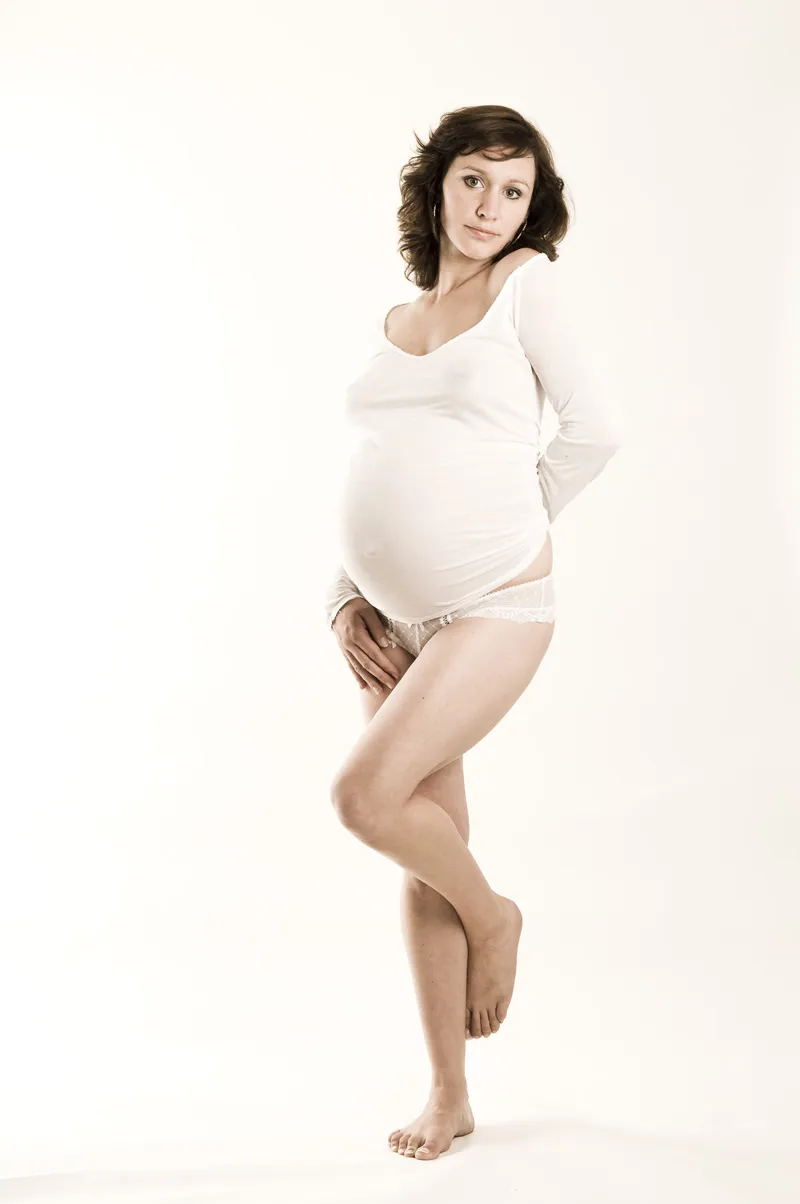
All this is reason enough for excited parents to look forward to the due date, and the anticipation often includes the desire to document the appearance of the baby's belly shortly before birth. A woman quickly gains 10-15 kilograms during pregnancy, some even up to 25 kilograms in the end, ...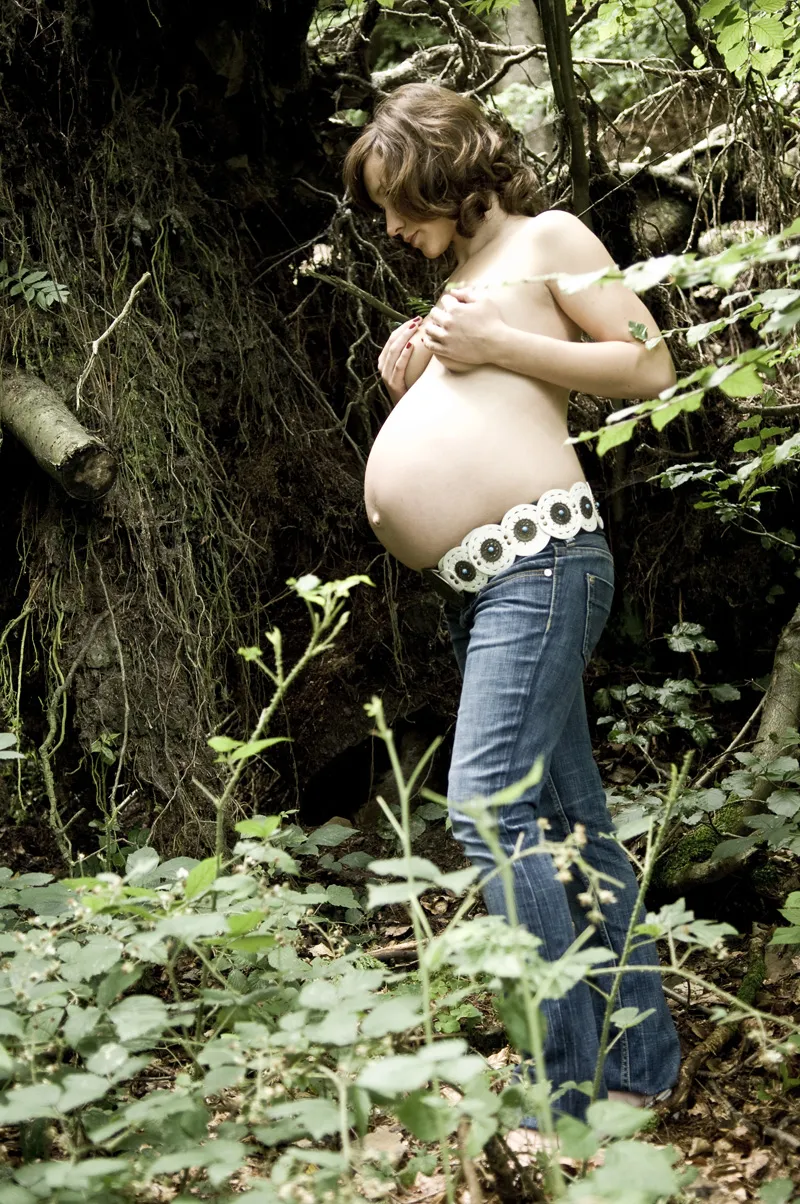
(Photo: Elli Bezensek)
... which is noticeable through a tight bulge of the "ball".
The photographer's task is now to make this shape "majestically beautiful", ...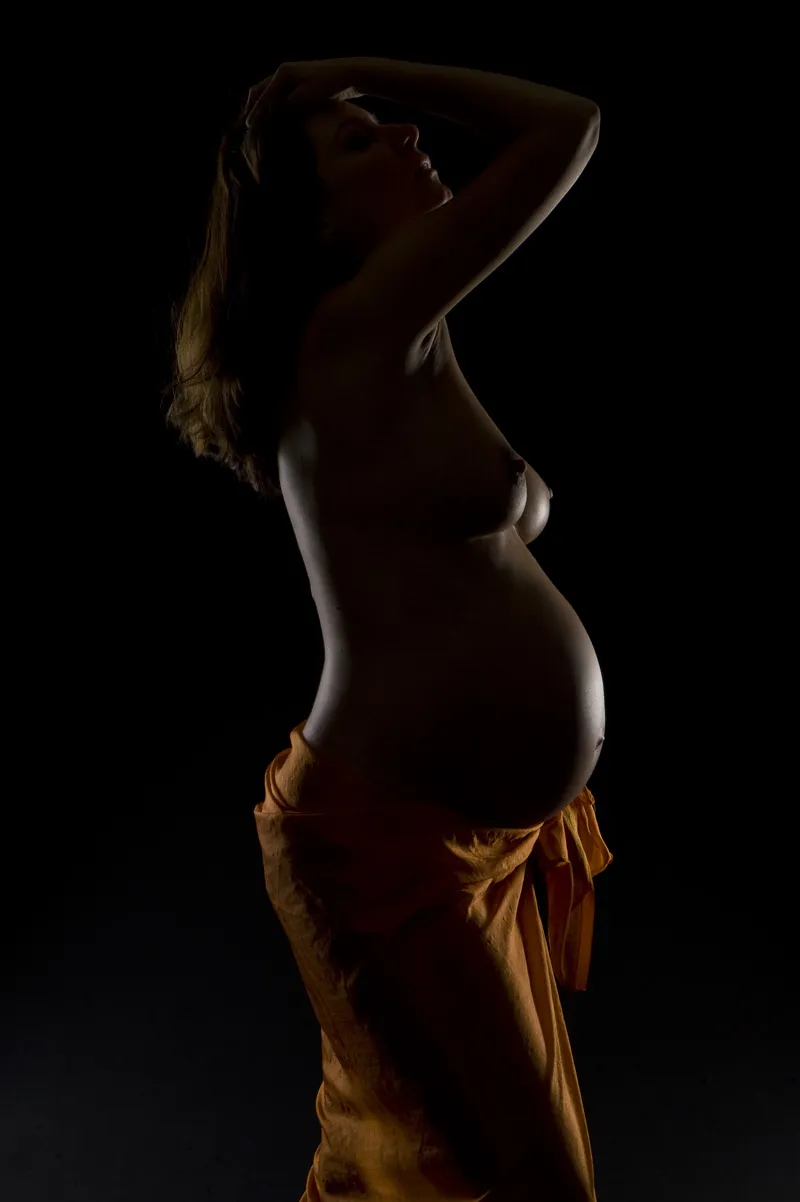
(Photo: Jens Brüggemann)
... but at the same time to hide the unwelcome thickening of the pregnant woman's thighs and bottom. This is achieved either by skillful lighting or by covering them with a skirt, dress or shawl.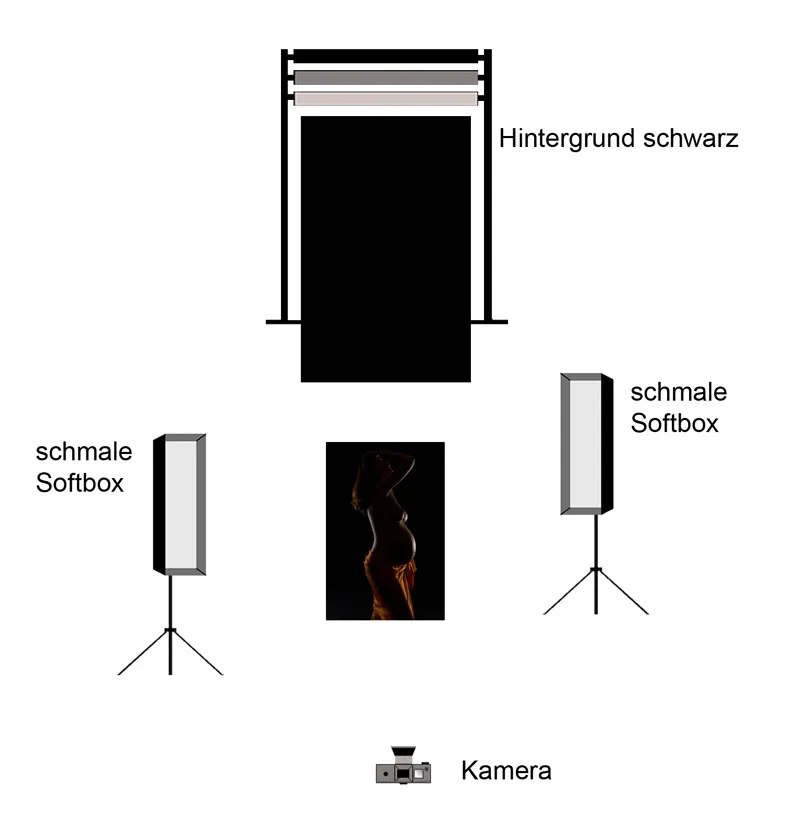
(Sketch: Jens Brüggemann)
Appointment question
What is the best time for pregnancy photos? Many women want to wait until the very last moment, i.e. just before the due date, to have their photos taken so that their belly appears really full and rounded in the photos. The disadvantage of this is that many pregnant women suddenly no longer feel "comfortable" in their skin in the tenth month, i.e. in the last few days and weeks, because everything is more difficult, every movement is difficult; the anticipation and pride of being pregnant give way to the eager desire to give birth soon ... (Photo: Jens Brüggemann)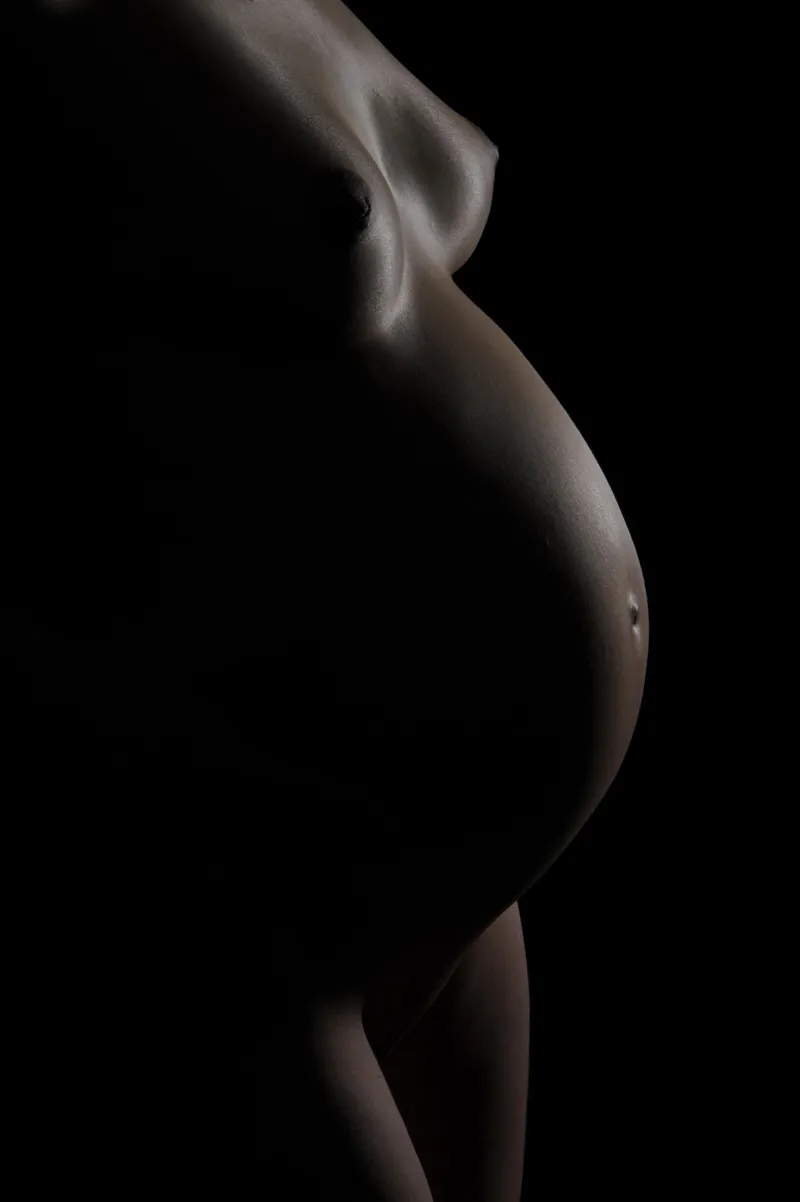
... (probably also to finally have a "normal" belly again with fewer restrictions in everyday life). There is also the risk of a premature birth, which is not uncommon these days. My son was also born 5 weeks prematurely, he was simply "ready". Fortunately, we had already taken the photos of the baby bump by then! So don't wait until the last moment, plan the shoot for the end of the ninth month (9th month = 33rd - 36th week), i.e. 6-4 weeks before the expected date of birth.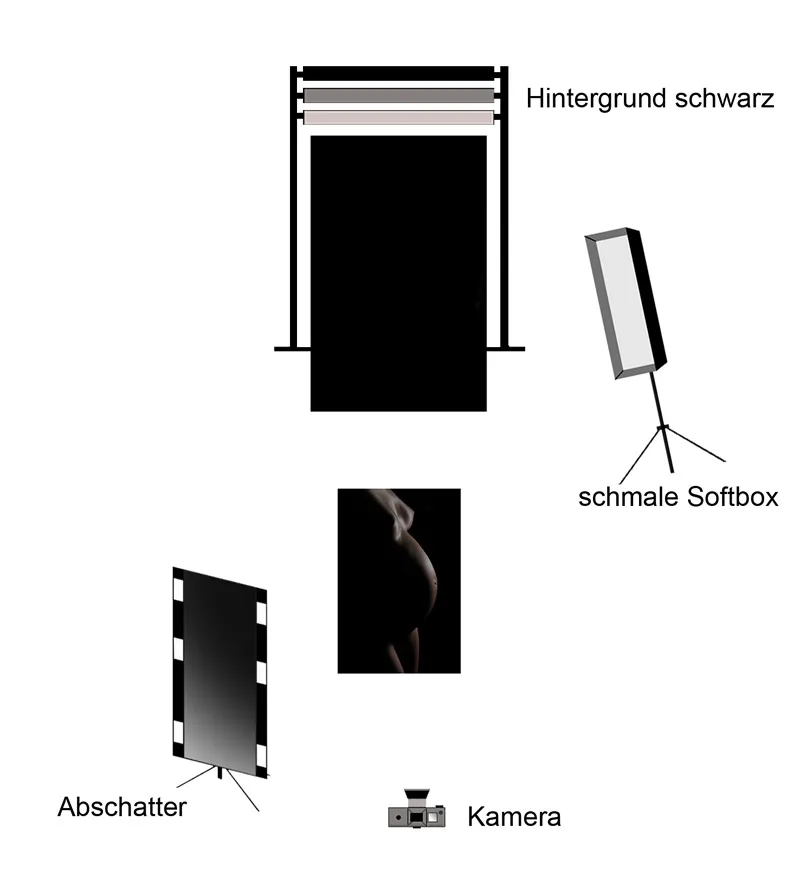
(Sketch: Jens Brüggemann)
In nature
Pregnancy photos are usually taken in a photo studio, but if the expectant mother is still "fit" and feeling well, there is nothing to stop her from taking photos of her baby bump in the open "untouched" countryside, provided of course that it is not too cold outside (and not too hot in summer).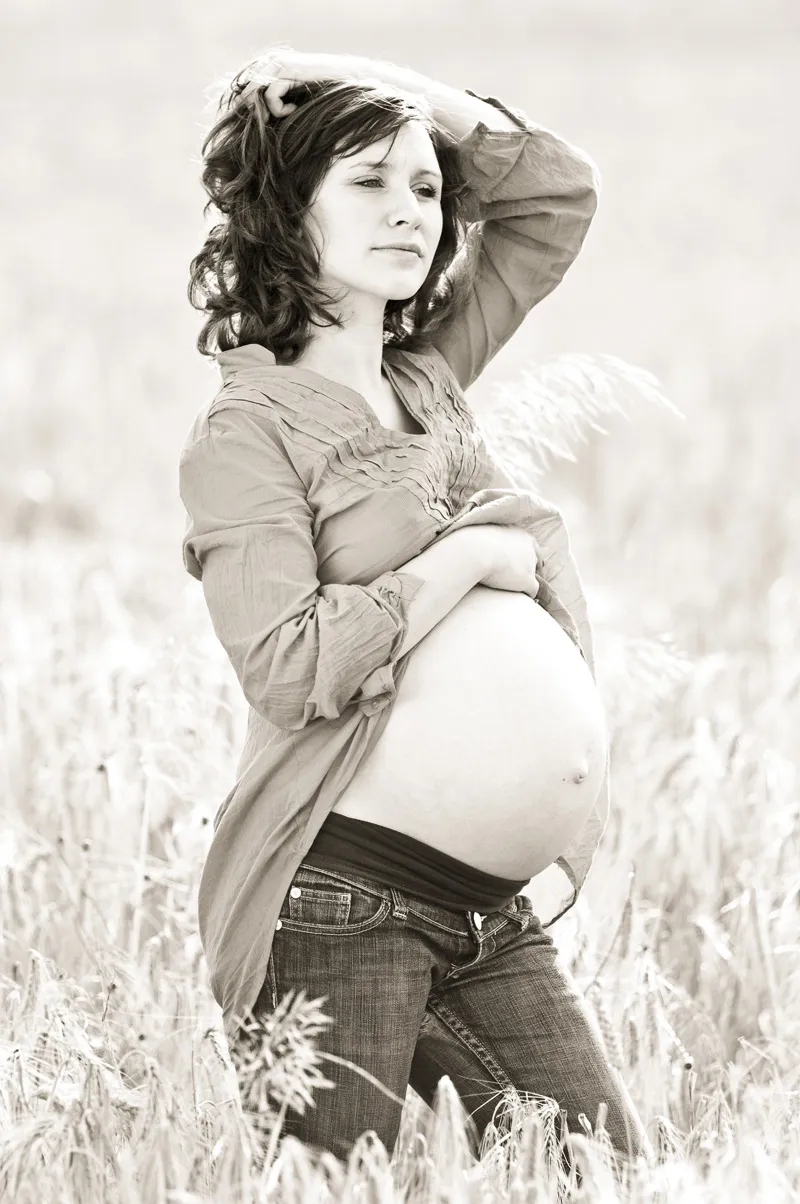
(Photo: Elli Bezensek)
Even if outdoor photos are a little more difficult for the mother-to-be, the result is completely different from studio shots: Nowhere does the romance and closeness to nature come across as clearly as in photos taken in a meadow, by the sea or in the forest.
But watch out for distracting elements in the background, such as a distant country road with trucks, telegraph poles, etc., as these would partly destroy the romantic character of the shot!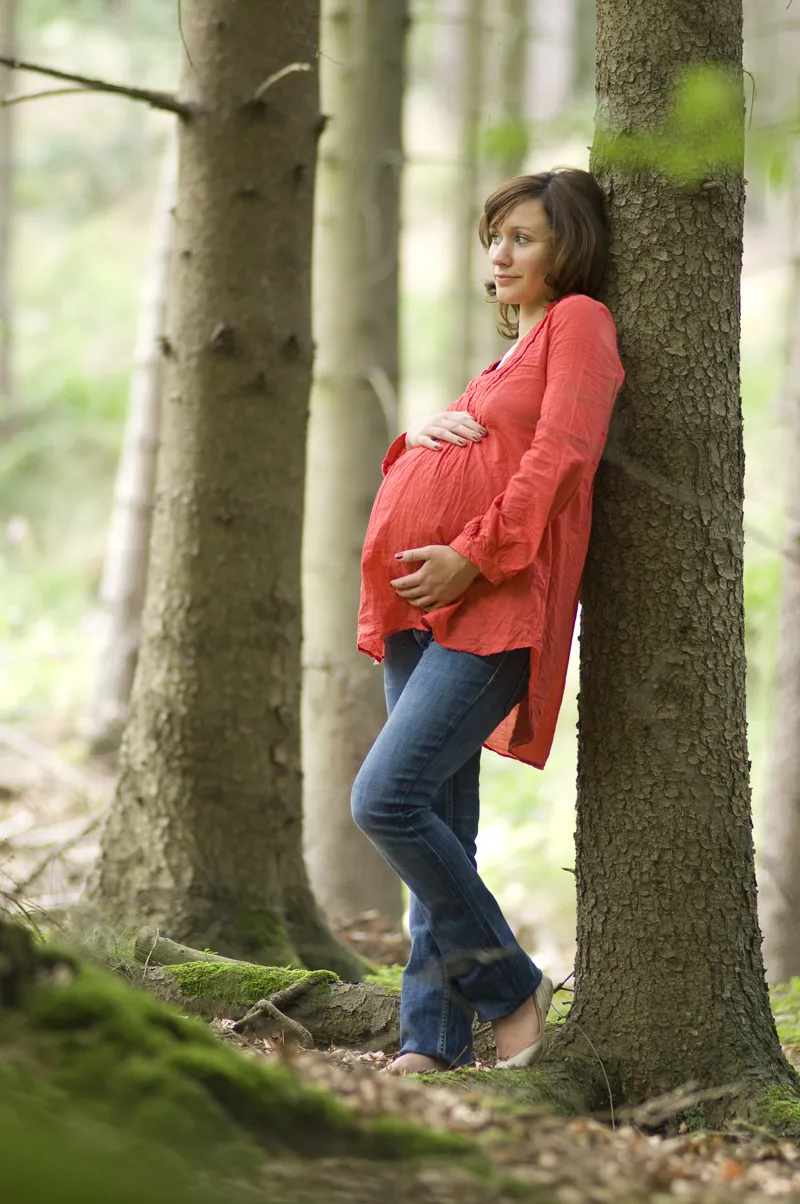
(Photo: Elli Bezensek)
In the studio
When shooting in the (home) studio, make sure that the pregnant woman feels comfortable, because her life is already difficult enough at this point (just put yourself in the position of having to carry a full crate of beer in front of you all the time!)
Room temperatures between 21 and 25 degrees Celsius (depending on whether the photos are taken largely unclothed, as is often the case) are ideal.
If you set up or change the lighting, it is best to offer the mother-to-be a chair, which she is sure to gratefully accept. Drinks should also be available so that the model can survive the (strenuous) shoot.
Be prepared for many small interruptions during the photo shoot, as the fetus usually presses uncomfortably on the bladder of pregnant women, which is why the expectant mother feels the need to go to the toilet every few minutes.
As a rule, the expectant mother wants to have the beautiful round shape of her baby bump (her pride and joy!) documented, which is particularly well achieved by placing one or two light edges.
As the breasts also swell in the last few weeks before the baby is born, many pregnant women want the photos that are to be taken to show not only the baby bump, but also their larger and firmer breasts.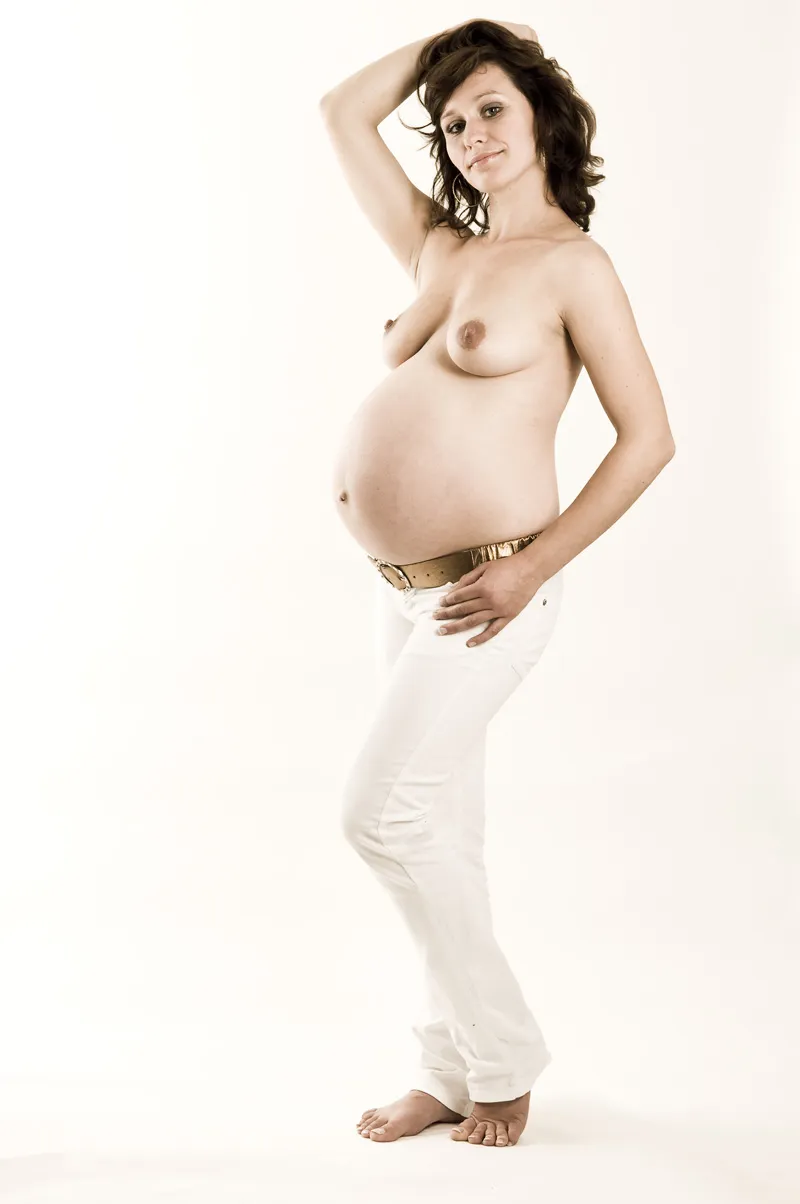
(Photo: Elli Bezensek)
In short: the first erotic photos that many women take in their lives are taken on the occasion of pregnancy, although the term "erotic" in this context is meant rather cautiously, because these types of photos are primarily intended to be "just beautiful"!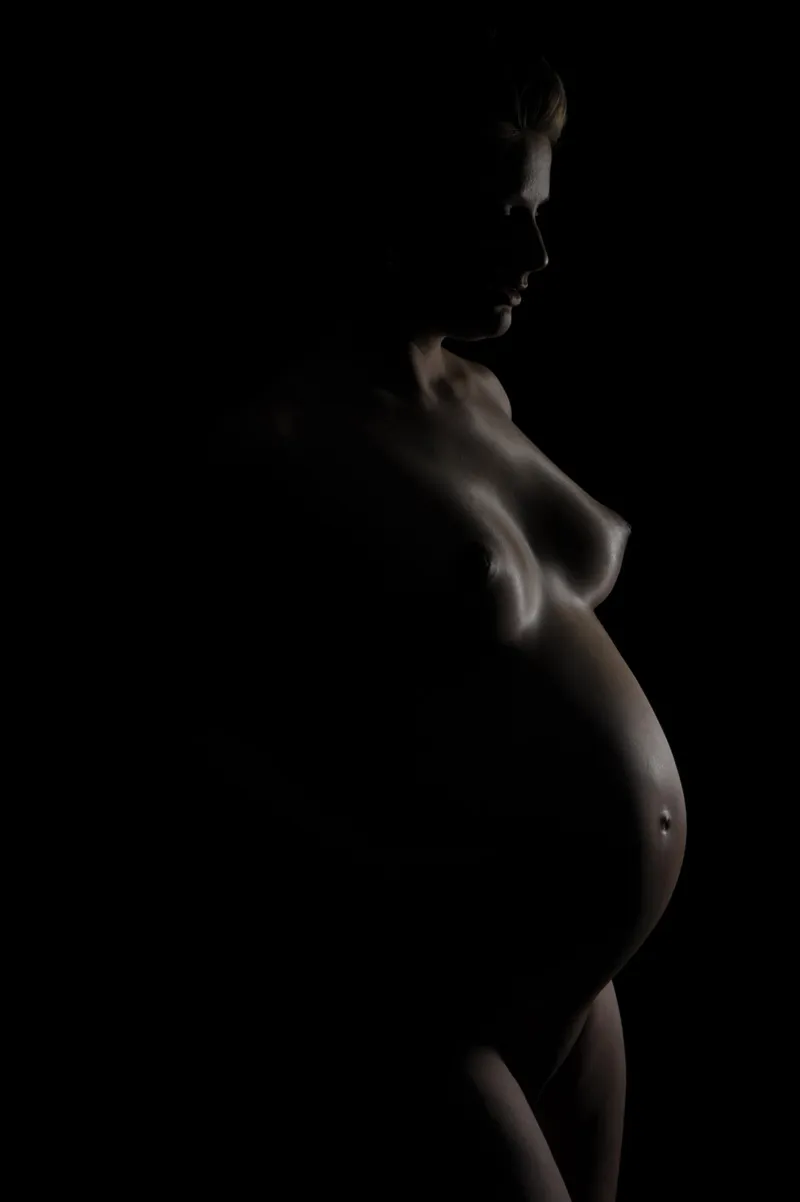
(Photo: Jens Brüggemann)
The best way to set the edges of the light to the left and right of the model is to use Striplites or very narrow softboxes.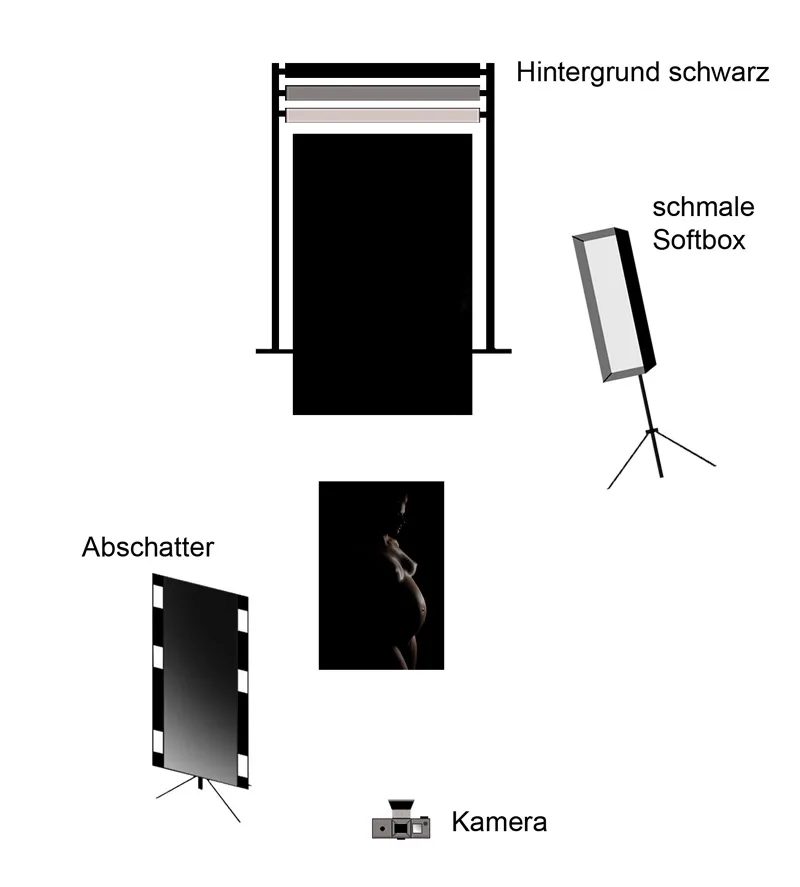
(Sketch: Jens Brüggemann)
Showing only the outline of the mother-to-be (against a black background) automatically leads to "low-key" photos. These photos should tend to be slightly underexposed, as otherwise individual areas, illuminated by the backlight, could "fray".
(Photo: Jens Brüggemann)
In some pregnant women, the "linea nigra" can be seen particularly clearly in the last few weeks before delivery, but not all expectant mothers find this "beautiful".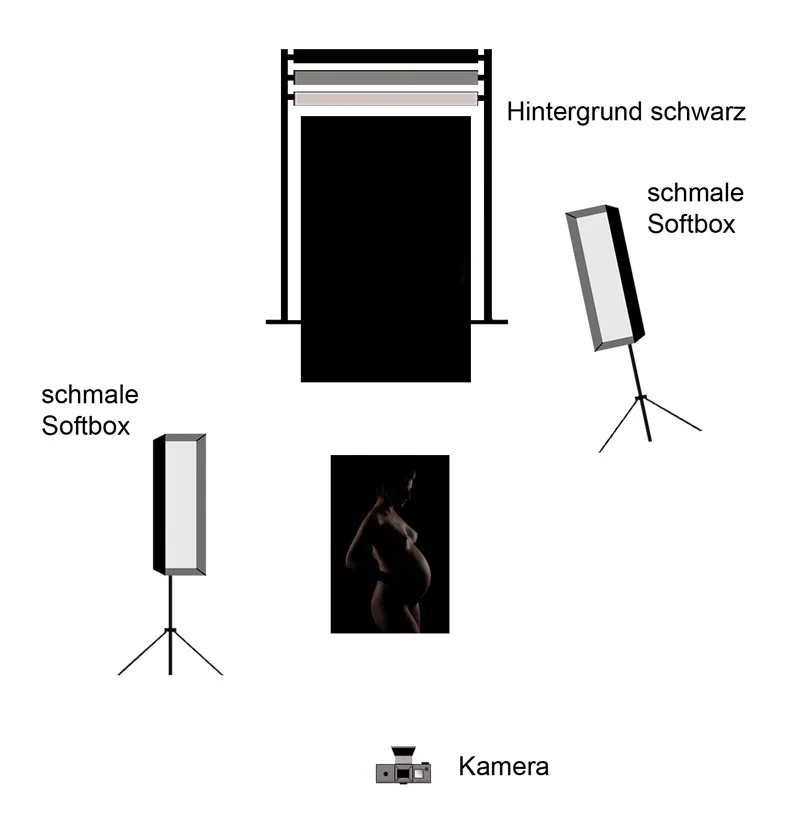
(Sketch: Jens Brüggemann)
It is best to clarify during the photo shoot whether your model would like a little "cosmetic surgery" using Photoshop in this respect, ...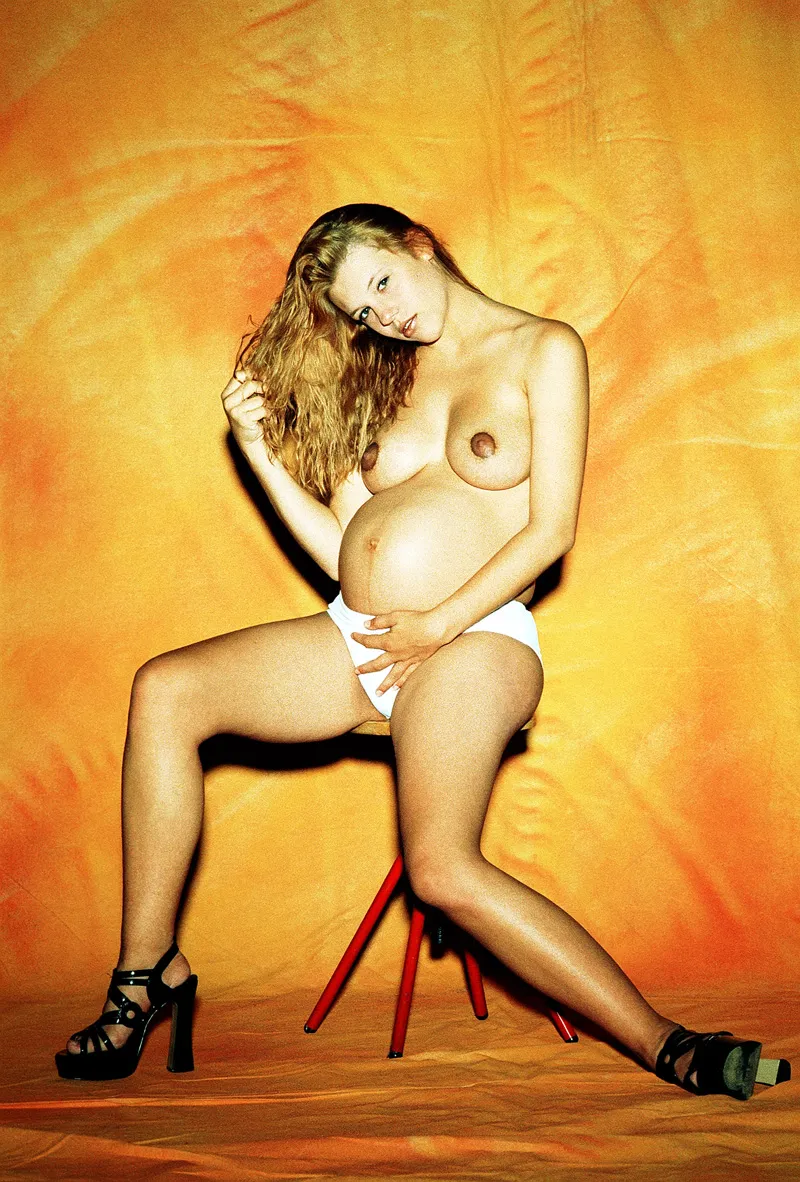
(Photo: Jens Brüggemann)
... after all, the photos should be a beautiful lasting memory of the difficult but beautiful time of anticipation for the baby!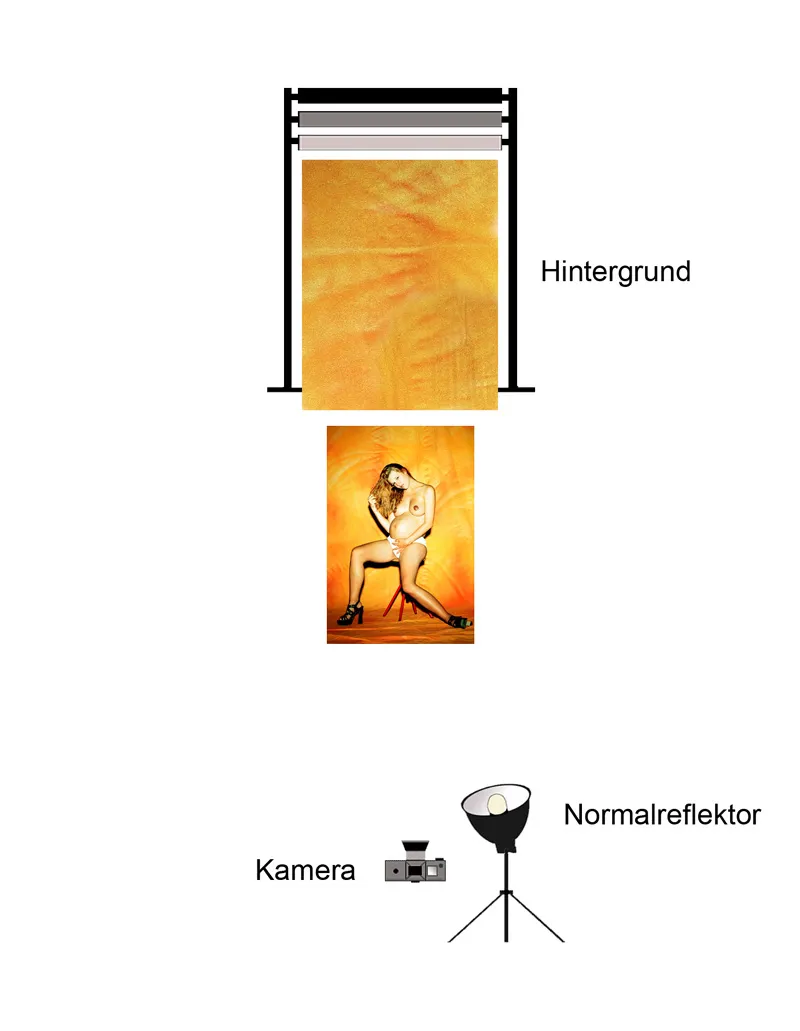
(Sketch: Jens Brüggemann)
Occasionally the father-to-be also wants to be in the photo, and what could be more natural than him stroking, patting, kissing or simply holding the belly of his loved one with the unborn baby inside?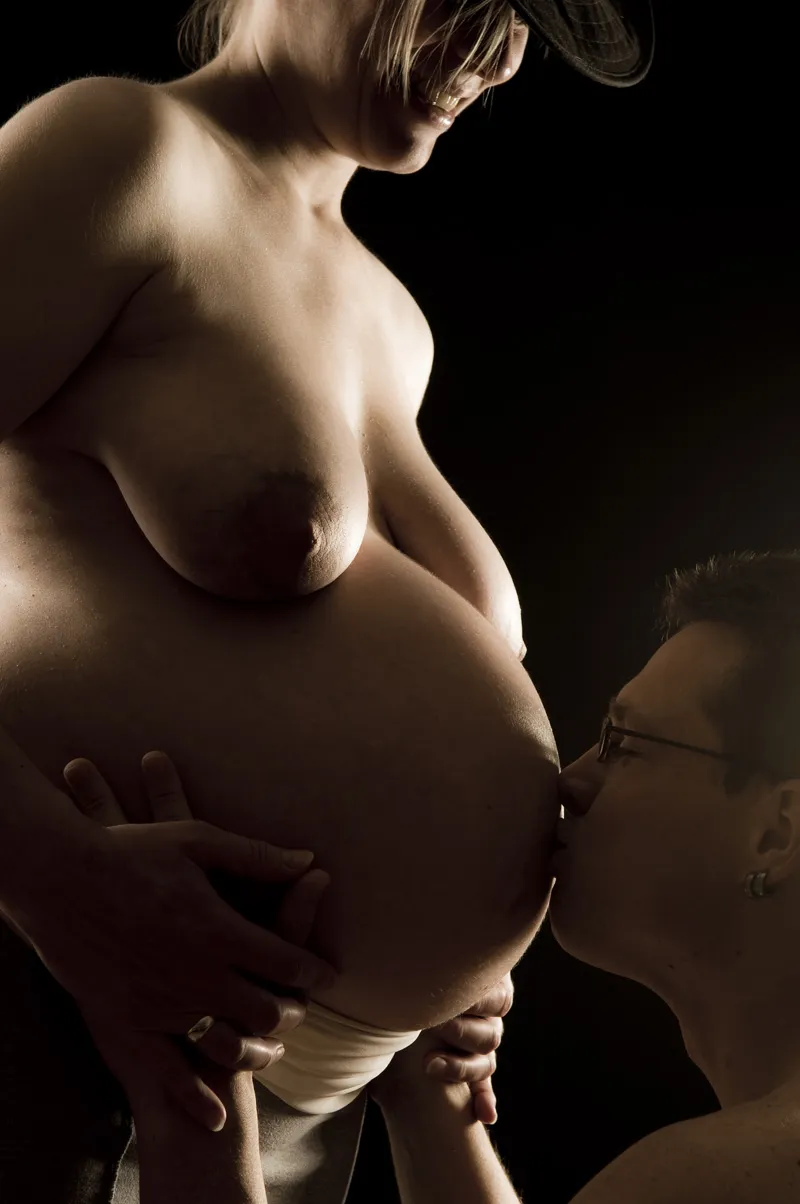
(Photo: Elli Bezensek)
Photos that document the anticipation of the soon to be expected offspring are also popular. It is often the little shoes or the first cuddly toy given to the newborn (who has not yet seen the light of day) that serve as props, so to speak, and thus provide a bridge between the world in the womb and the first days after birth, where the shoes only have the task of keeping the newborn's little feet warm and are not yet used for the first steps, which will come much later ...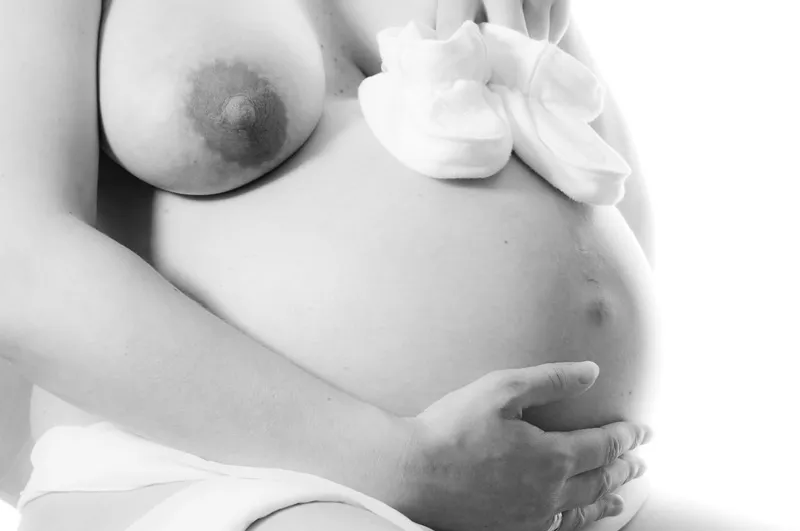
(Photo: Elli Bezensek)
Newborn babies
Birth is the most drastic human experience: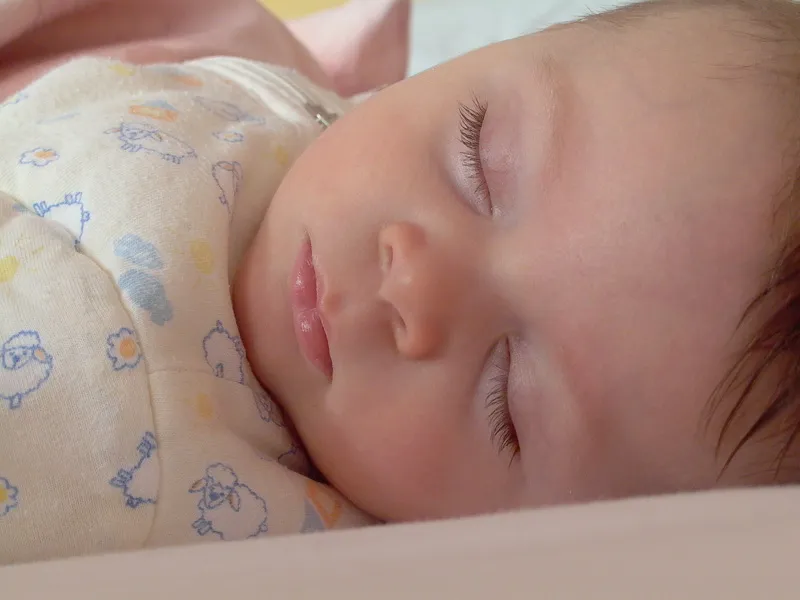
(Photo: Jens Brüggemann)
For the mother, the long-awaited moment has finally arrived, which she has been anxiously looking forward to all this time (between check-ups, birth preparation courses and labor stress tests). The fear of the birth process mixes with the joyful anticipation of being able to curiously examine the newborn, hold it in her arms and care for the baby. The birth of the first child is something unique and new!
But it's not just the joy of having a baby, negative feelings such as fear of the future, resignation and depression also mix with physical exhaustion to create a contradictory cocktail of emotions (postpartum depression is not uncommon!)
For the father, the birth of the first child changes EVERYTHING! While the preparations in the run-up to the birth were characterized by many organizational and practical activities (from shopping and setting up the cradle, changing table and additional cupboards to making the home safe by installing childproof sockets, installing smoke detectors, hiding power cables, clearing away fragile vases, etc..., that the baby could throw down, installing cupboard and door stoppers, removing all matches, lighters and plastic bags from the child's reach, purchasing a fire blanket and fire extinguisher, installing safety rails on the stairs, attaching shelves to the wall, disposing of poisonous houseplants, etc.., to stocking up on diapers and garbage bags), the presence of your own offspring only really becomes clear to you directly after the birth, when the little worm on the changing table in the hospital receives its first care (still from the midwife and doctor) ...
Suddenly I was a FATHER, I had responsibility, I became vulnerable. All of a sudden I was a different person, and the most important thing in the world was no longer the Schalke win against Bayern or accelerating from 0 to 100 in 7.8 seconds, but the successful "burping" of my first child ... It's horrible! Terrible! Beautiful!
For the baby, the birth process is a brutal squeezing and pushing and being pulled out of the security of the amniotic sac in the womb into a loud, cold, glaring world full of unfamiliar sensory impressions.
From one moment to the next it has to learn to breathe, it has to cope with the multitude of loud noises (in the womb all noises were always muffled!), it has to endure the bright light (in the womb it was always nice and dark!), the newborn has to learn to suckle at the breast (previously the fetus got everything it needed via the umbilical cord) and has to communicate if something is wrong (because before everything was "automatically" regulated).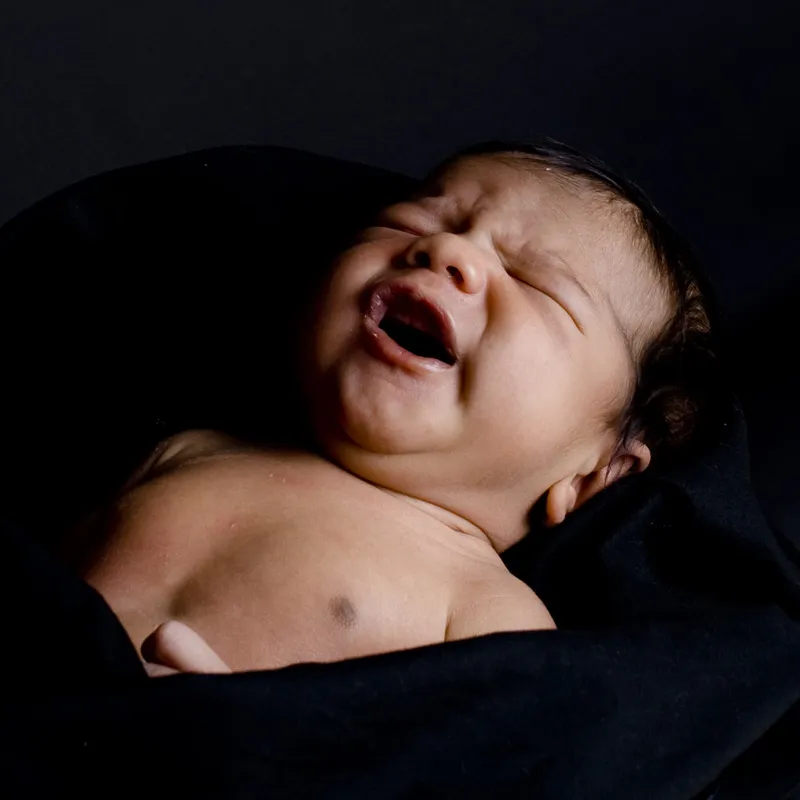
(Photo: Elli Bezensek)
What a challenge the little new inhabitant of the earth has to face without being asked!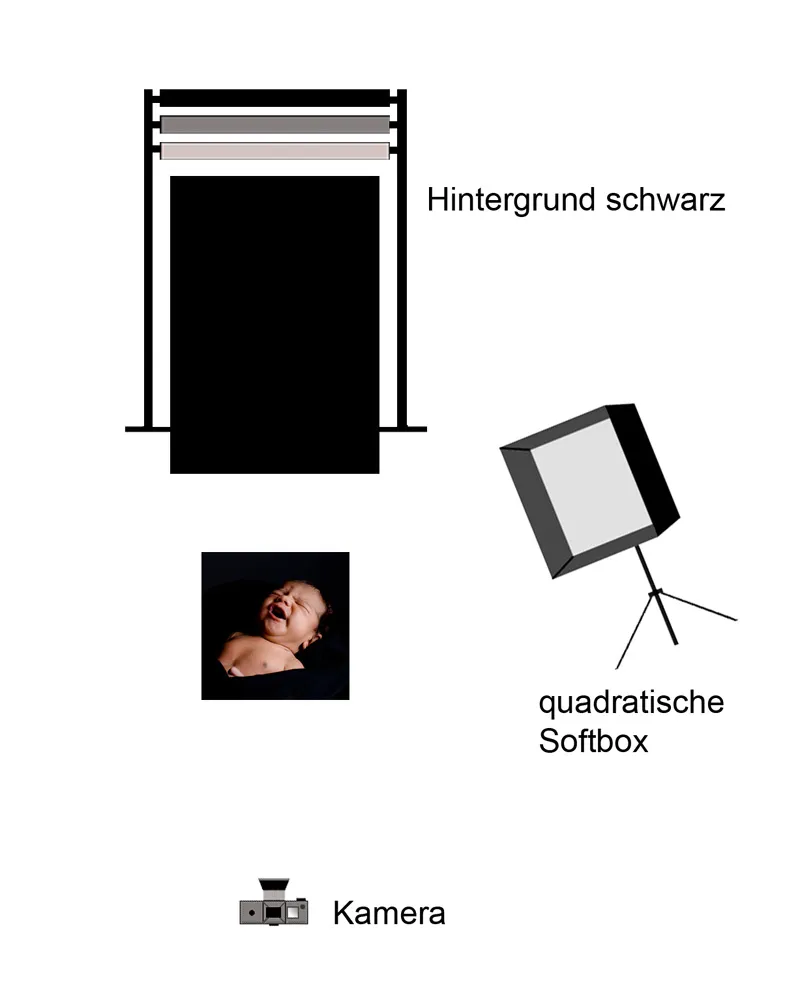
(Sketch: Jens Brüggemann)
At birth
With all the terrible sensory impressions during birth, photographers should not add even more "terrible" new experiences to the newborn; in short: you should refrain from using a flash! This is also what almost all parents' guides demand, at least for the first few days or weeks.
The risk of damage to the retina definitely justifies this measure! And even after that, it is best not to flash directly into the eyes, but instead to use the flash indirectly, for example via a white ceiling (or white wall or brightener).
It makes sense to set the camera manually to the slowest possible shutter speed (between 1/30 sec. and 1/250 sec. depending on the model and optics used) and the widest possible aperture. Of course, you have an advantage if you have fast lenses (so use fixed focal lengths if necessary!)
This also allows you to take pictures in available light, as is usually the case in the delivery room (subdued light).
The highest possible value should be selected for the light sensitivity, whereby the limits of what is tolerable in terms of the noise behavior of the camera at the set ISO value must be observed; depending on the camera model, this will be between 200 ISO (compact digital cameras) and up to 6,400 ISO (for example with the ingenious Nikon D3S).
It is not possible to make any statements about the white balance at this point, the conditions in the delivery rooms are too different. If in doubt, even I would choose the automatic function. The photo shows a baby immediately after birth under a heat lamp.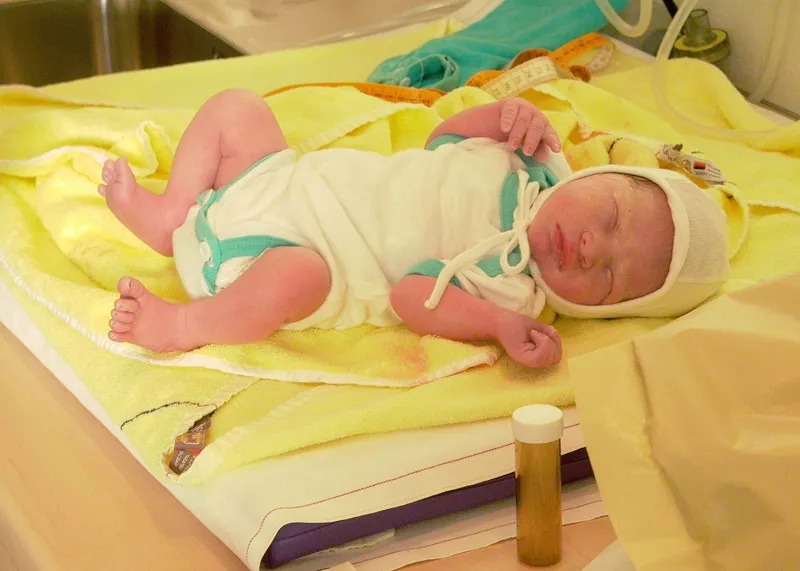
(Photo: Jens Brüggemann)
The first few days
In the first few days, everything is different at first; hectic errands alternate with moments of intimate peace (when you are holding your baby in your arms).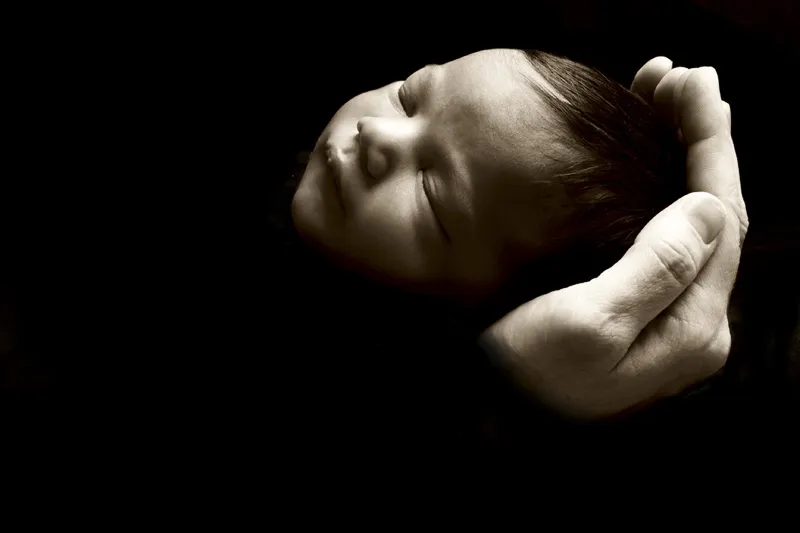
(Photo: Elli Bezensek)
The "human miracle" only really becomes apparent these days when a newborn suddenly becomes part of the closest family circle.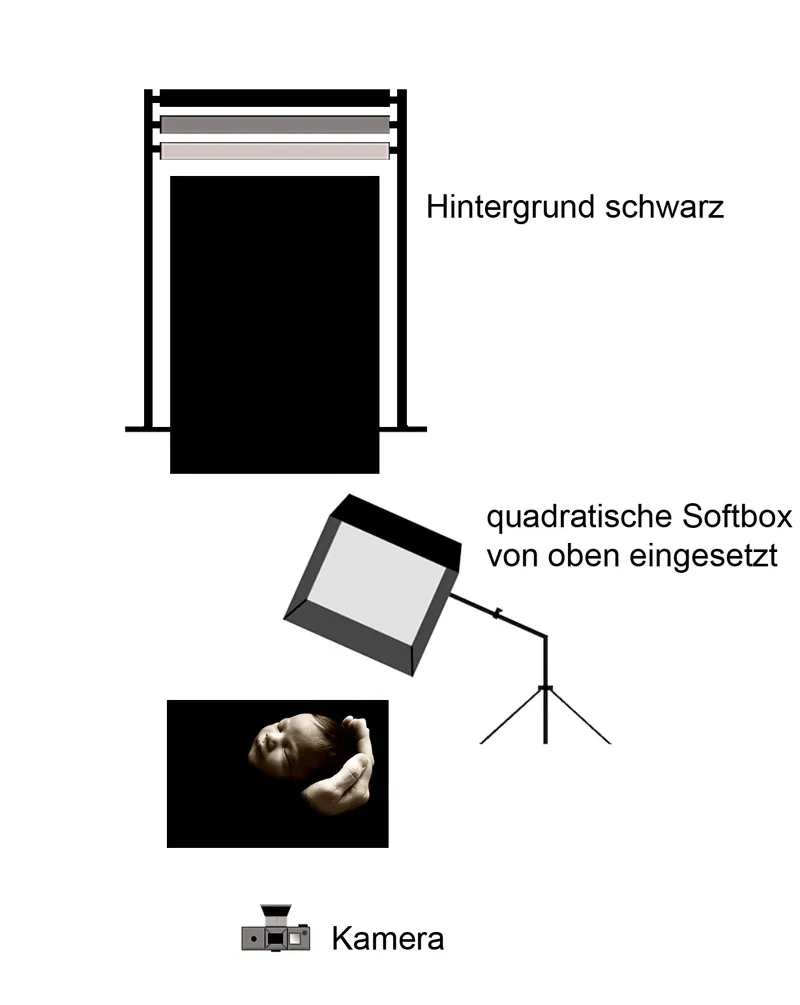
(Sketch: Jens Brüggemann)
Of course, the grandparents also want to see and hold the "new one" as soon as possible, and so you should always have a camera to hand in hospital to document the grandparents' first contact with their grandchild.
As in the delivery room, it is also important not to use a flash during the first few days. If you are taking photos with a compact camera with a built-in flash, you should make sure that it has been switched off manually before taking the photos. Here, too, the advantages of the fastest possible lens become apparent.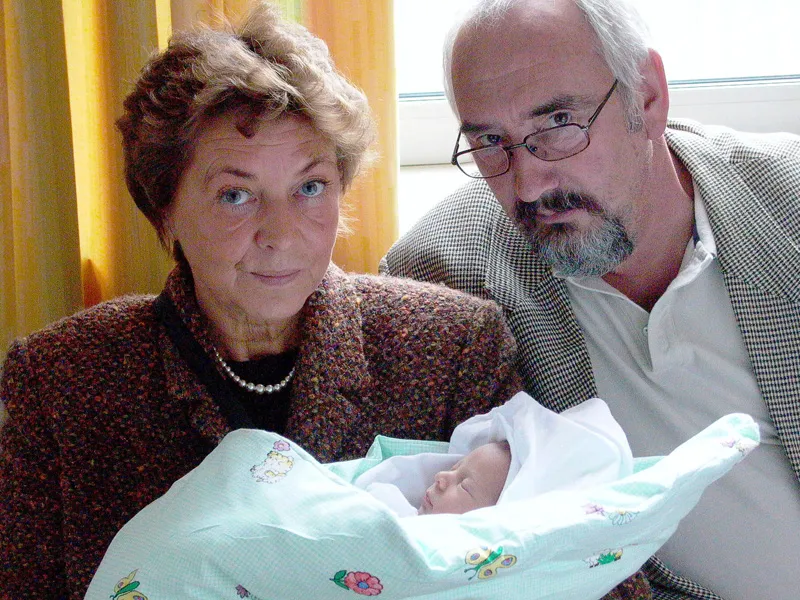
(Photo: Jens Brüggemann)
The baby spends most of the first few days sleeping, which looks very cute and above all peaceful. Typically, in the first days and weeks after birth, the little ones clench their fists while sleeping.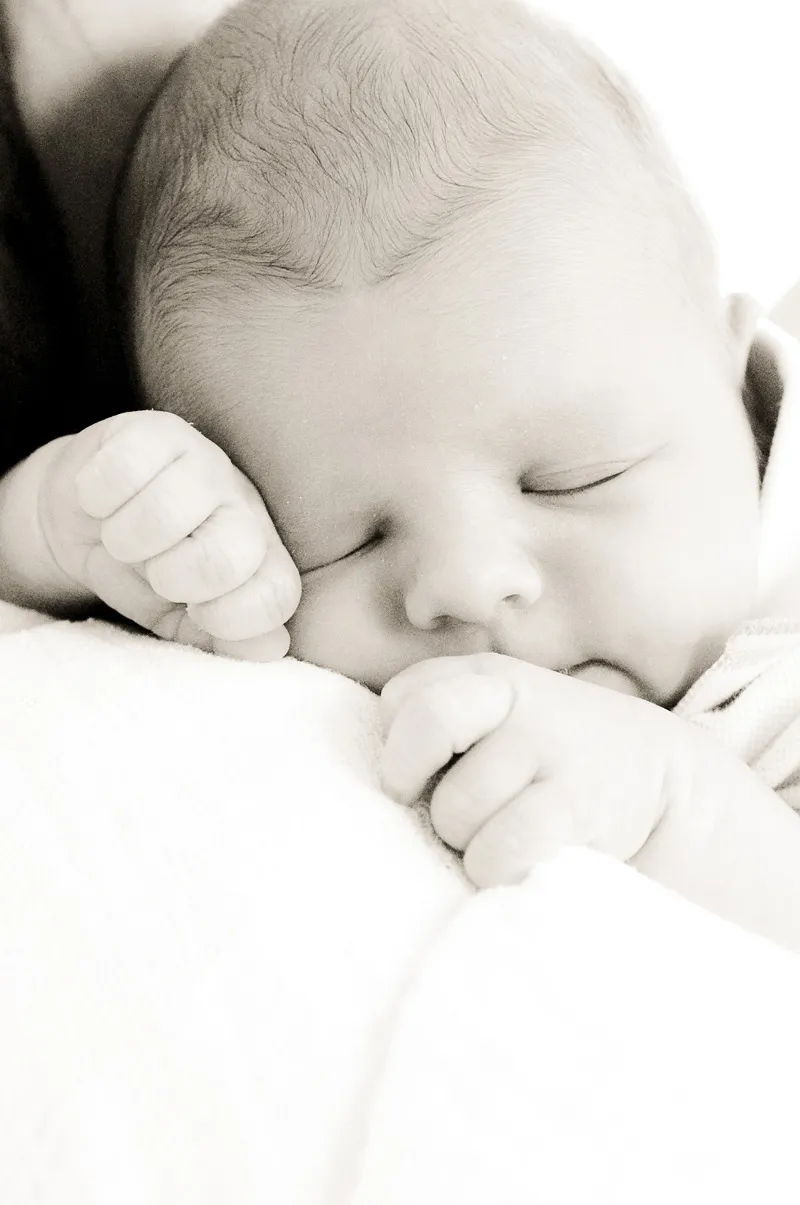
(Photo: Elli Bezensek)
As parents would never normally photograph their children crying (because that's when their help is needed, you don't watch and you don't take photos!), there are consequently almost only photos from the early days in which the offspring can be seen sleeping peacefully in all positions: in the crib, in the arm, in the baby carriage, on the changing table, at the mother's breast, ...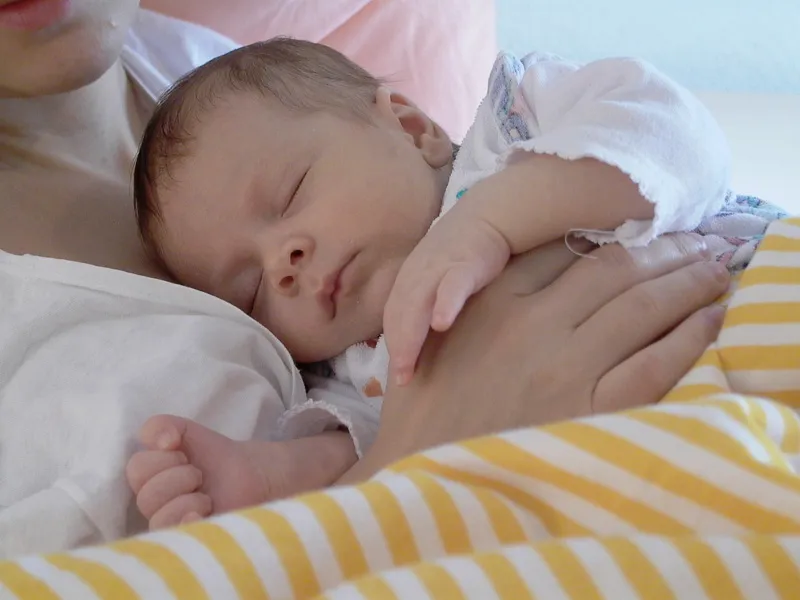
(Photo: Jens Brüggemann)
For hormonal reasons, many newborns develop acne, i.e. small sebaceous pimples, in the first few days after birth. These mainly sprout on the nose, forehead and cheeks. This is completely natural and nothing to worry about, but if it really bothers the parents (especially if photos are to be sent to critical relatives), there is always the option of carrying out the first beauty retouching work in Photoshop ...
(Photo: Elli Bezensek)
Babies
(0 - 1 year)
Babies aged between one and a half and three months are already developing all sorts of amazing skills, for example, they already fixate on toys (preferably colorful ones), orient themselves towards sounds, gurgle with pleasure, can hold an object that you put in their hands (but not yet grasp it), they also move their arms and legs a lot when awake and can even lift their heads and shoulders from the floor when they are placed on their stomachs. (Photo: Elli Bezensek)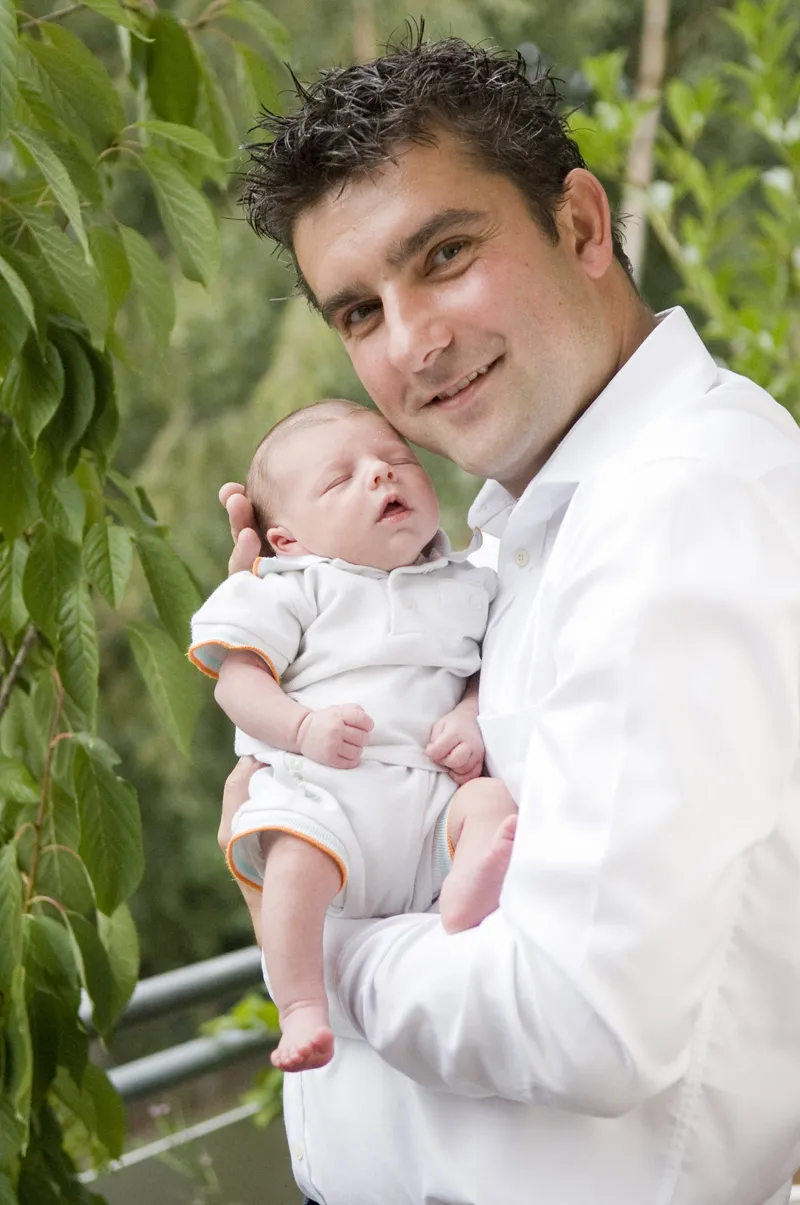
And, what is probably the most beautiful ability for parents: They respond to their parents and other people (when they are smiled at or spoken to nicely), with (back) smiles and noises. My wife used to say: " That's the most beautiful toothless smile there is!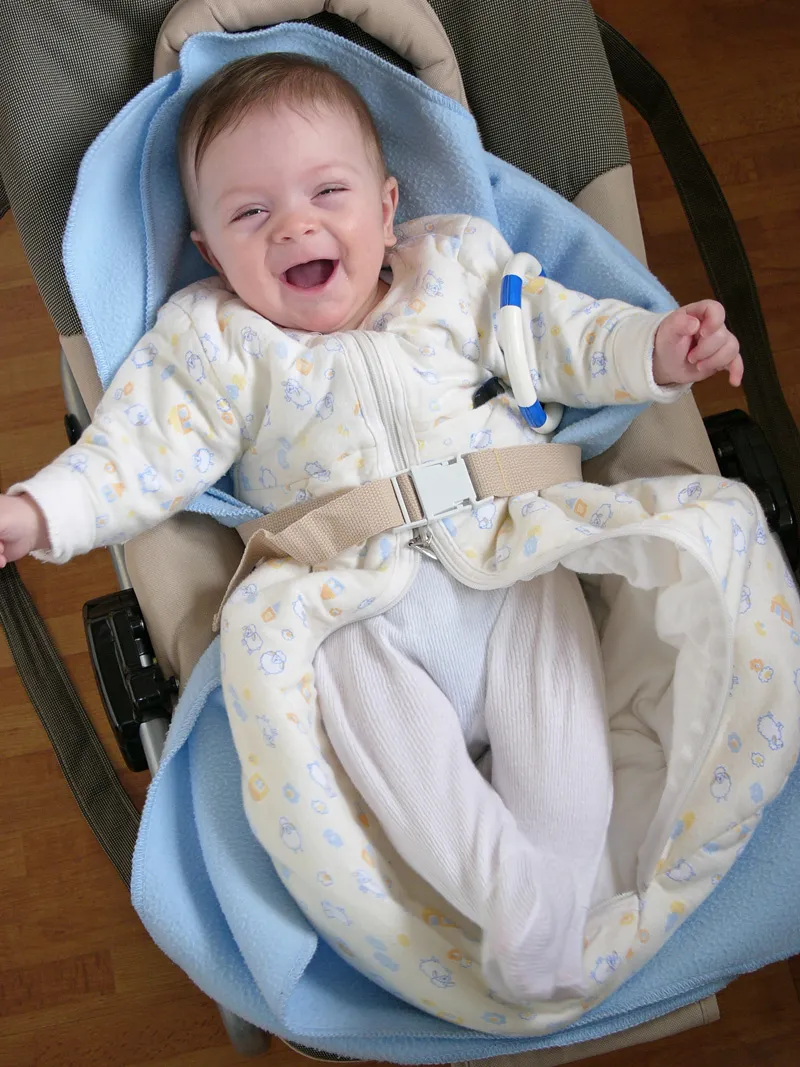
(Photo: Jens Brüggemann)
Between three and six months, the baby learns to look more closely at objects, it begins to imitate its parents, for example when you stick out your tongue, it laughs, babbles and giggles and turns towards the person who is speaking.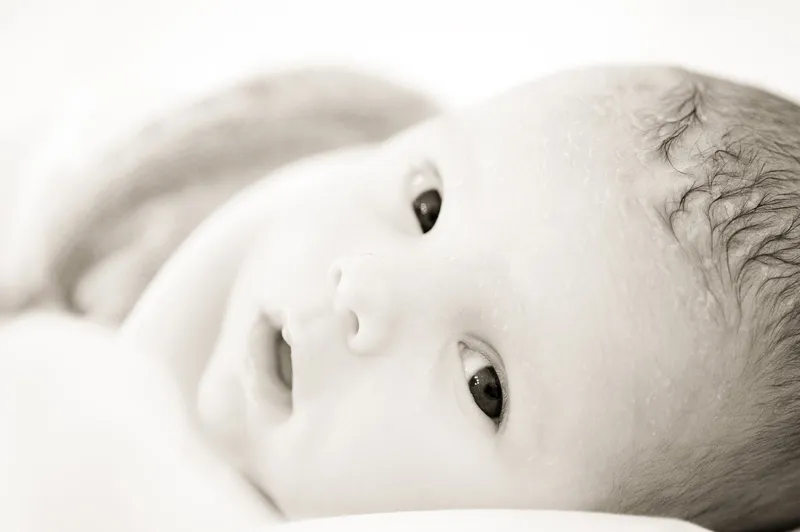
(Photo: Elli Bezensek)
It reacts with sounds, even when it hears its name, and starts to put everything it can grasp in its mouth (including its own feet, which at forty-one years old I can no longer do even with practice).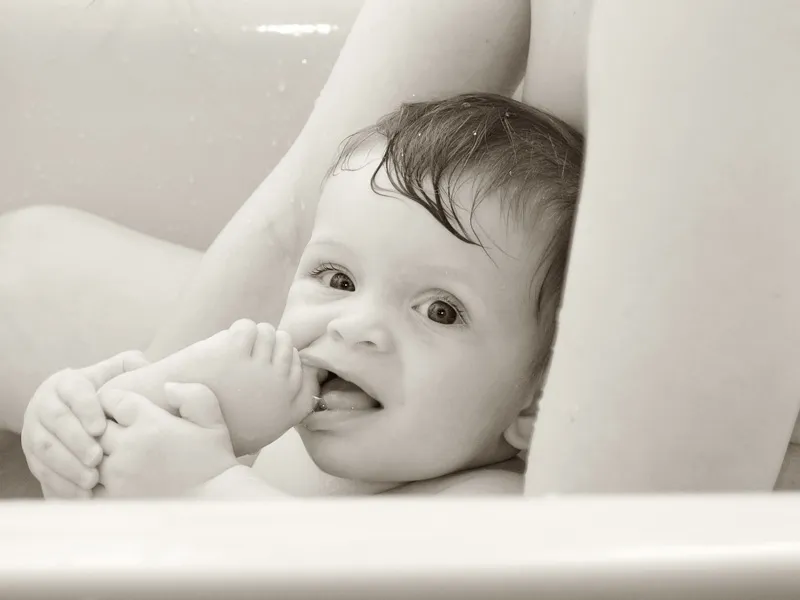
(Photo: Jens Brüggemann)
Baby usually holds toys and other things with both hands and throws them away again. It is happy to have company and shows this (by babbling, giggling and making "ba" or "da" sounds).
If your child is baptized, don't forget to record this moment for posterity. If you are too involved in the ceremony yourself, ask a friend to take a photo at the crucial moment. If necessary, hand him or her your pre-set camera to make sure that the photos are at least technically taken according to your ideas.
As most of the churches I know are very dark, the use of a bright lens is crucial for the success of the photos. Alternatively, you may have a camera that allows you to use high ISO values without any noticeable image noise. For this photo, my former assistant used the Nikon D3 with a setting of 3200 ISO (1/160 sec., Blender 6.3).
Flashing indirectly with a system flash unit in churches usually makes no sense due to the typically high ceilings. (And hopefully after reading and understanding this article, no one will ever use direct flash indoors again).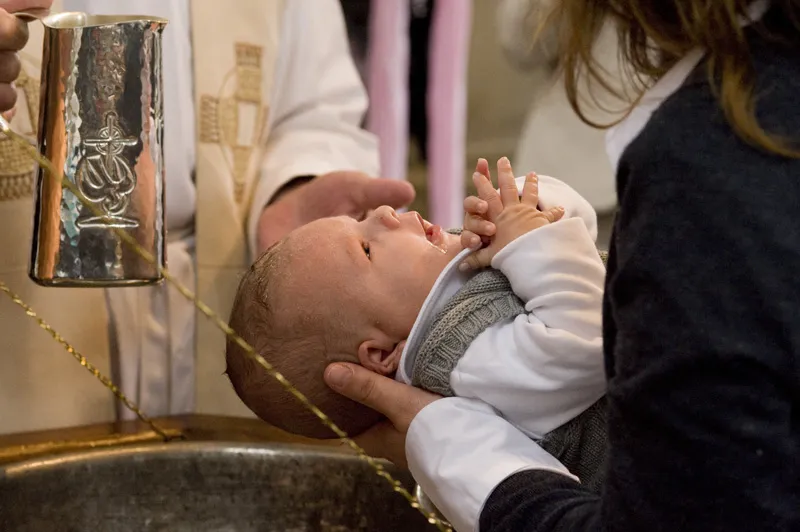
(Photo: Elli Bezensek)
In the three months after that, between six months and nine months of age, baby learns to poke around and point at objects, can sit for up to a minute and put itself in a sitting position, responds to its name, makes "winki winki" and singing noises. Babies notice people and their comings and goings and start to protest if they are (seemingly) left alone. A certain "attachment" is developed.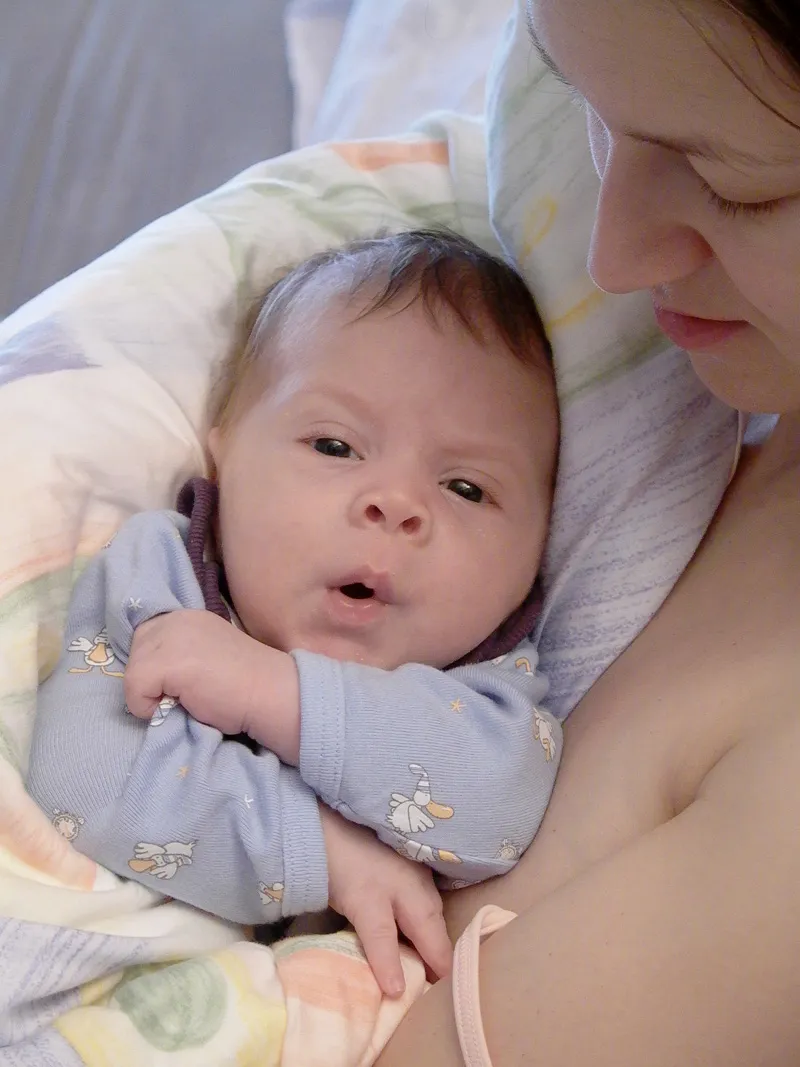
(Photo: Jens Brüggemann)
During this time, I tried to photograph our offspring without flash if possible, which was not always easy and often meant setting high ISO values. I took this photo in our small bathroom, which fortunately had a very large window.
And as the apartment was on the sixth floor and we had a clear view of the Ruhr landscape, I was able to take many beautiful photos with the light coming in through this window, even in the winter months. The fact that the room was so small and had a white ceiling and white walls resulted in a beautiful and even brightening.
If you photograph such moments in black and white, it no longer matters if you mix daylight with artificial light. So turn on the ceiling lamp for even more light and accept a color cast, because you will no longer notice it after converting the photo to black and white.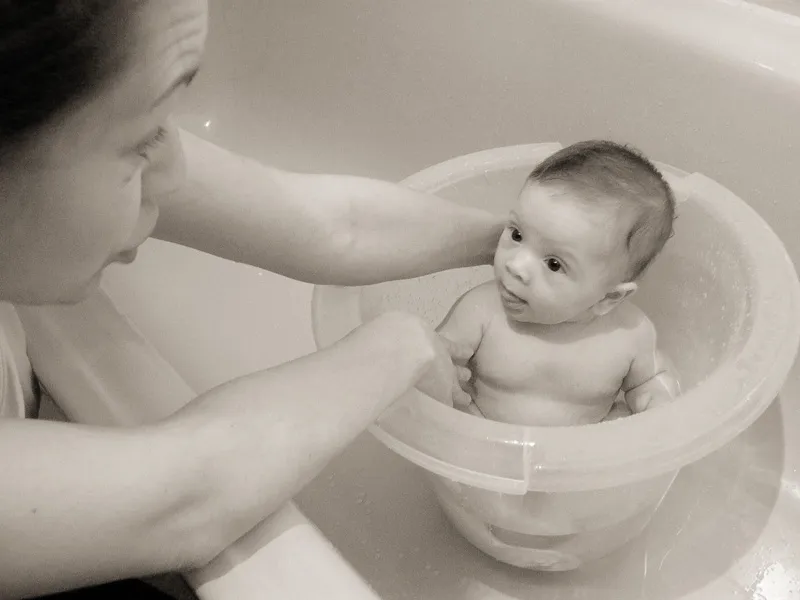
(Photo: Jens Brüggemann)
Many irretrievable moments can be captured on camera, especially when caring for a baby. Even if you have a lot of stress with caring for your baby in the first few months, take the time to at least take a photo of all the stages. I would never have thought back then that I would miss the hectic moments of changing diapers once my little one was older and more independent ...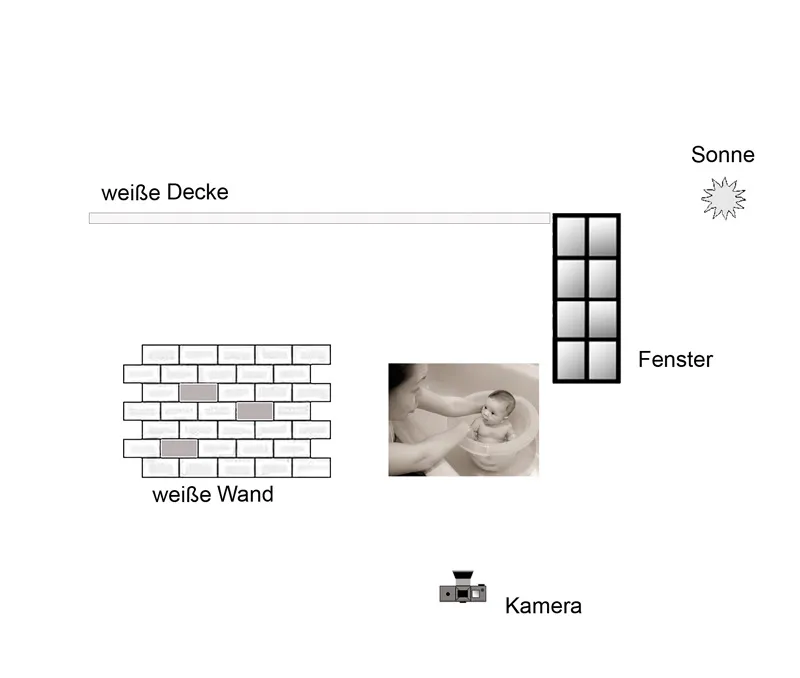
(Sketch: Jens Brüggemann)
Babies in the first few months spend most of the day sleeping. (Unfortunately, this is not always the case at night ...!) No matter what the little ones have done during the rest of the day, no matter whether the vase given to them by Aunt Kristina has been knocked down or Daddy's boxes have been hammered with wooden blocks, babies look like angels when they sleep and you can't blame them for anything, you can even forgive them for drooling all over the computer keyboard. Enjoy these moments when baby is sleeping peacefully, watch them again and again, because at some point they too will pass.
(Photo: Jens Brüggemann)
Between nine months and one year, your little one learns to crawl and creep perfectly, wants to eat independently with his own spoon and likes to hear himself babble.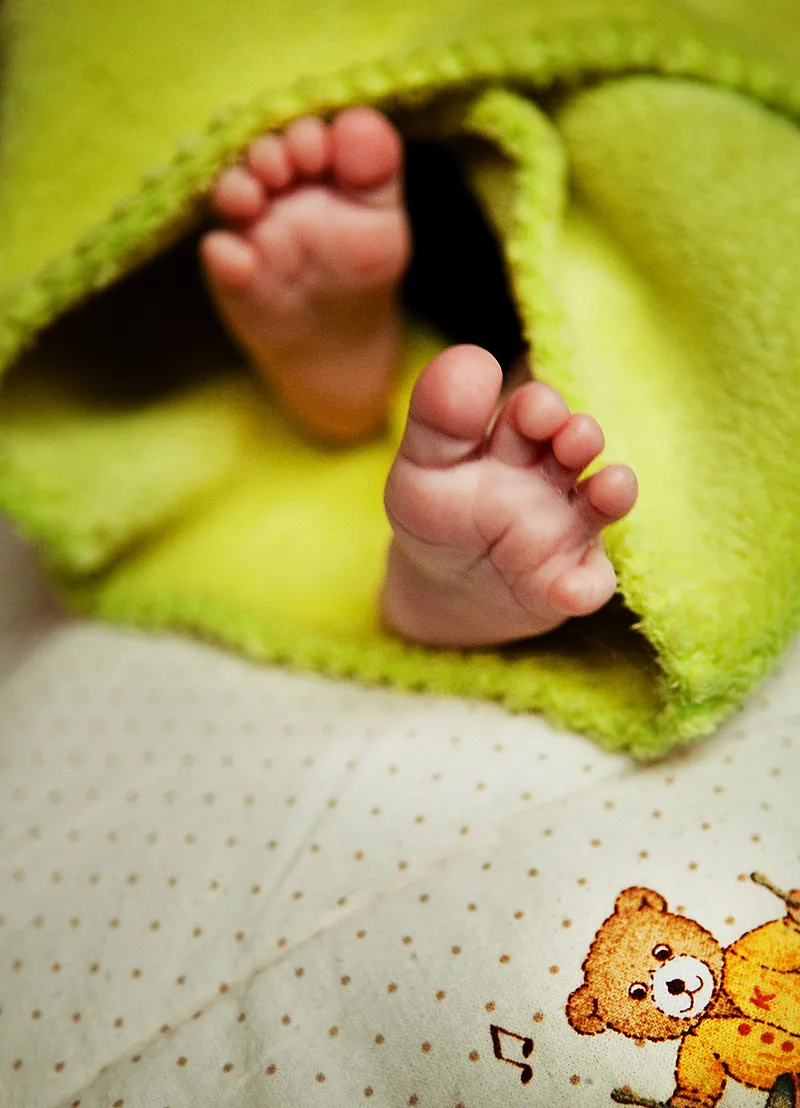
(Photo: Radmila Kerl)
His world is expanding. Baby can sit safely and is already trying to stand and is starting to look for his favorite toy after mommy has brazenly tidied up the room again. With a pen in hand, they scribble or poke at the paper (or sofa, carpet, chair, daddy's stereo speakers, etc.).
Babies are happy to meet people they know, but are reserved towards strangers. Even before they reach the age of one, babies understand many words, questions and statements, and requests are eagerly followed. For example, baby will hold toys or other objects out to you when asked ...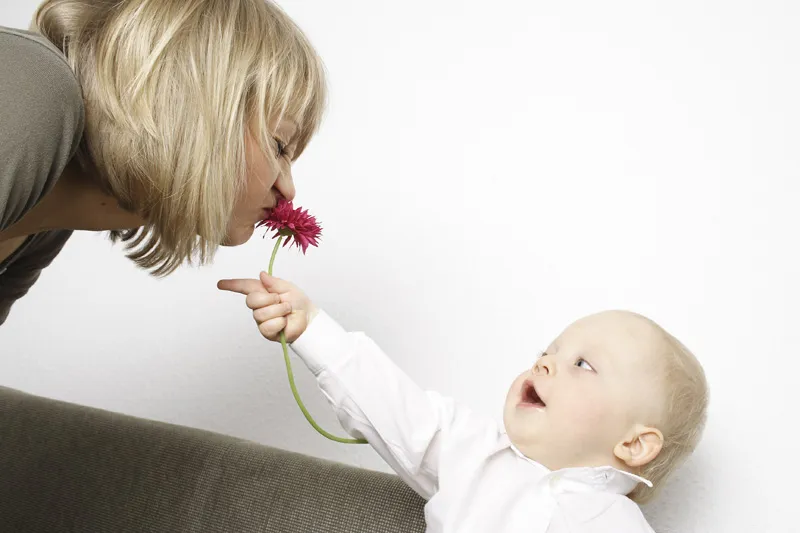
(Photo: Elli Bezensek)
... (or, in less good moments, throws them at you).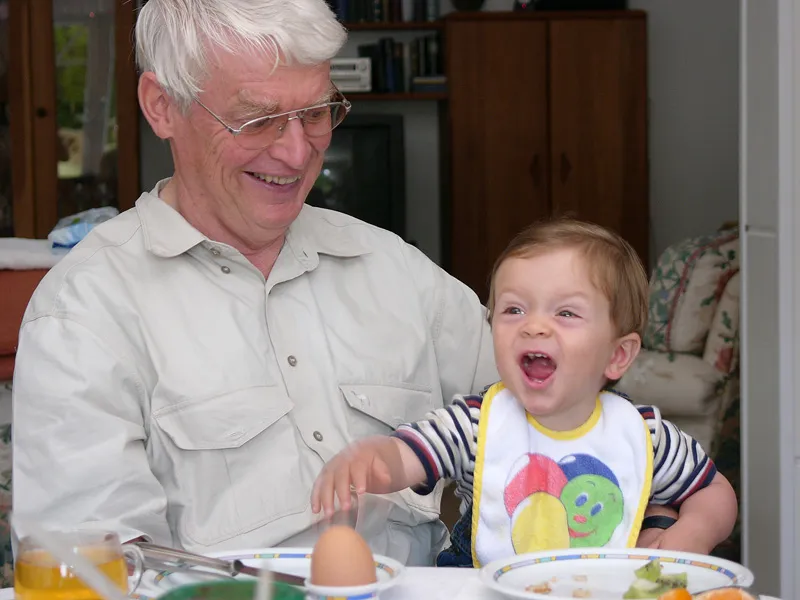
(Photo: Jens Brüggemann)
Toddlers
(1 - 2 years)
Toddlers between the ages of one and one and a half fully develop their vision; they can also identify sounds accurately. The first words are used meaningfully and spoken clearly. Despite various attempts to influence him, my son's first word was not "daddy" but "car" ...
(Photo: Jens Brüggemann)
Toddlers of this age often practice their speech by babbling at length. They leaf through books and look at the pictures in them. They have become more curious.
They also try to imitate their parents, which usually looks very funny (for example when talking on the phone, reading the newspaper, doing housework, etc.), but sometimes also leads to a lot of tidying up, for example when the offspring discovers the spice salt shaker in the drawer ... (Photo: Jens Brüggemann)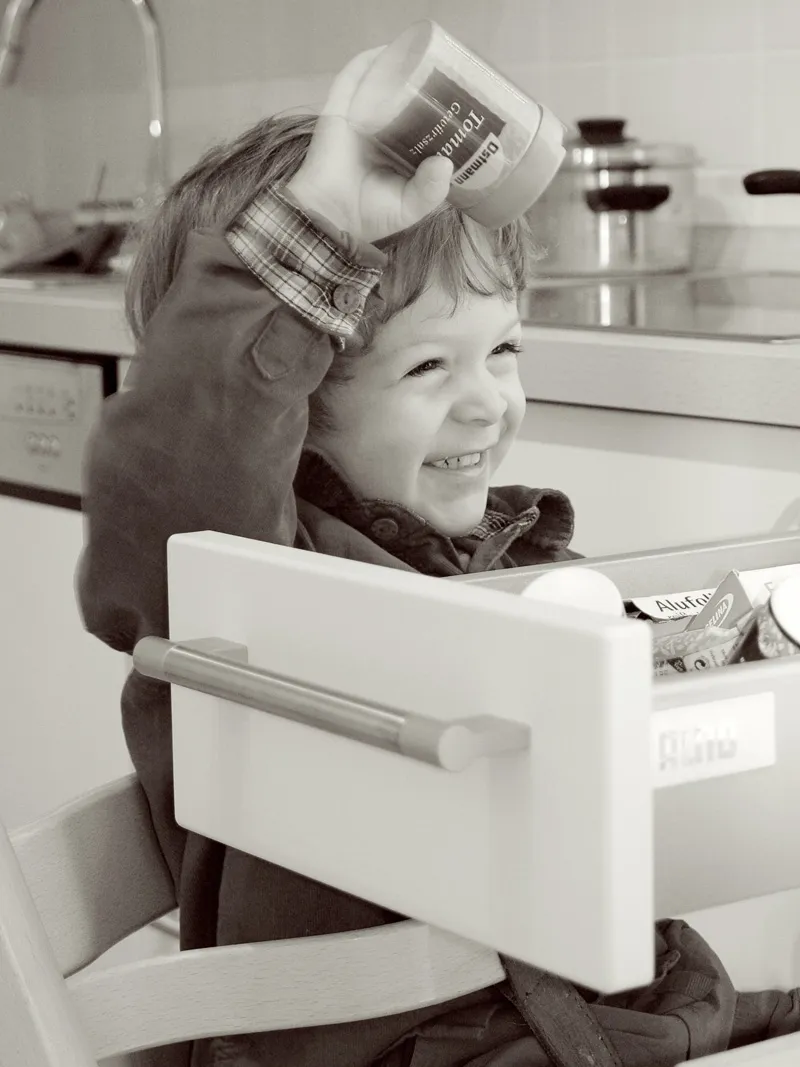
... or, almost like mom the day before, tidies up the drawer with the Tupperware ...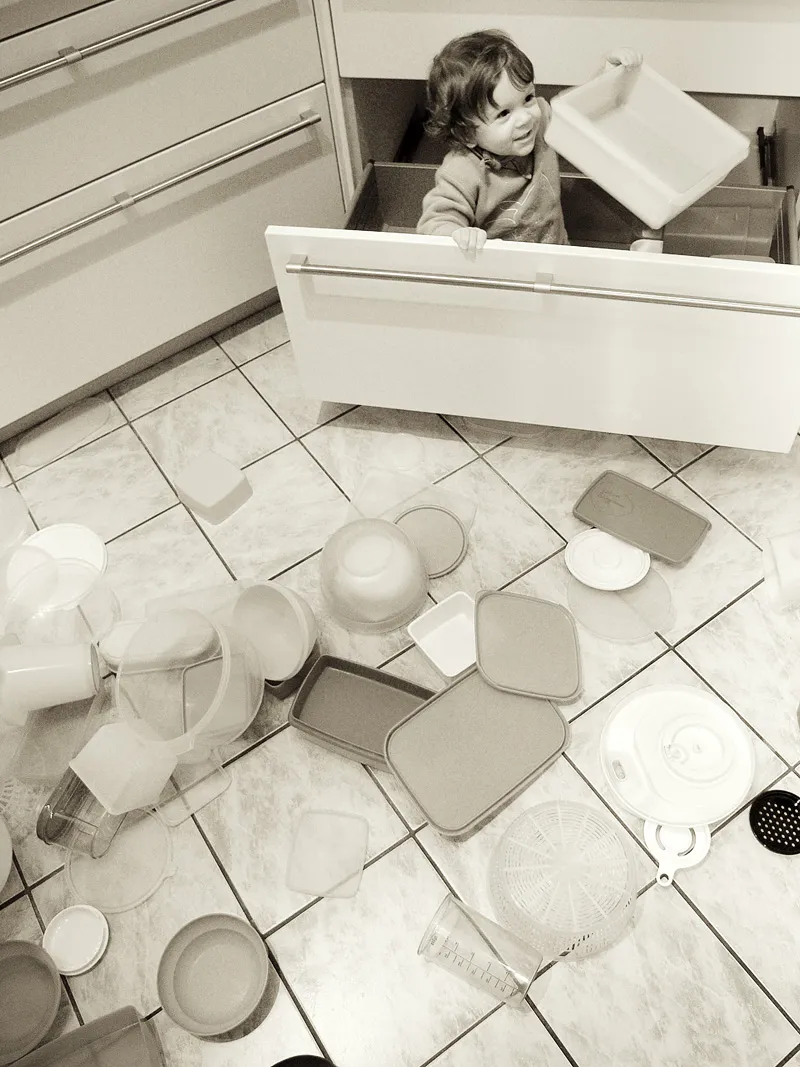
(Photo: Jens Brüggemann)
Children of this age walk safely, can throw balls, doodle a lot and build their first towers out of building blocks. They crawl up stairs, climb onto chairs or even into their parents' bed. The little ones even learn to walk backwards during this time. When getting dressed, they help their parents by stretching out their arms or legs. Not all of these skills are always helpful; for example, our son regularly took off his slippers and stockings at will during this time ... It's the beginning of the "I can do it on my own!" age.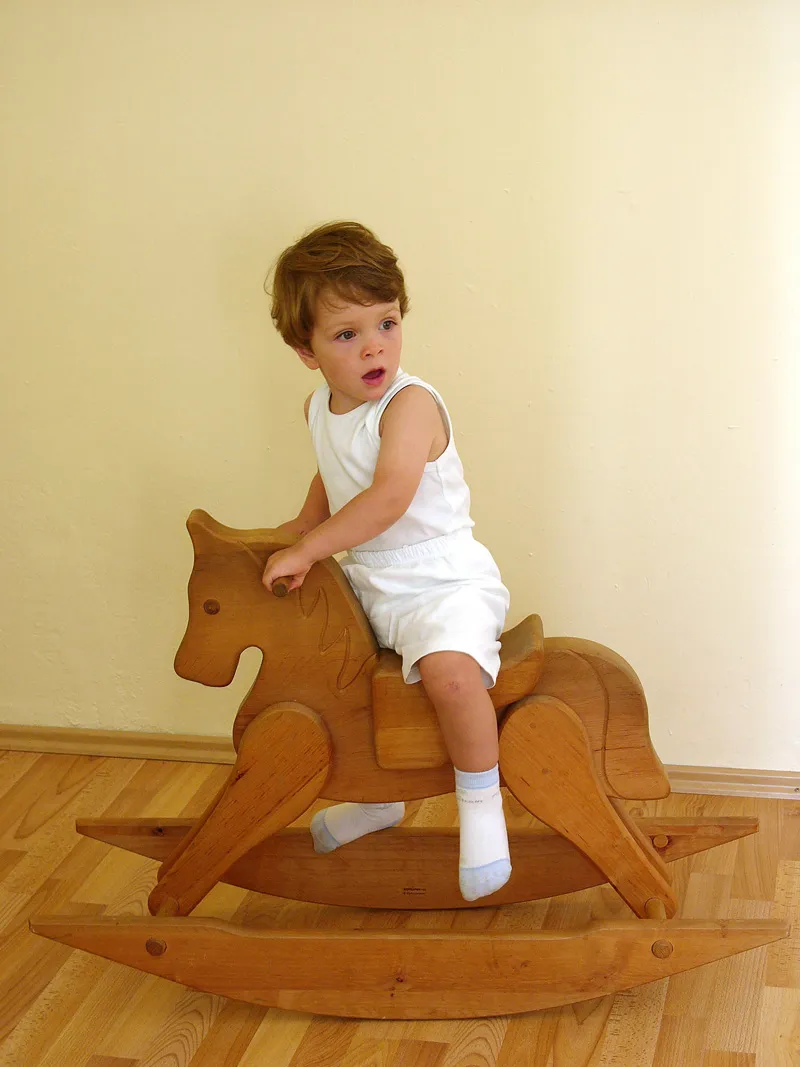
(Photo: Jens Brüggemann)
In the following months until they reach the age of 3, the little ones become more and more independent. However, as their independence grows, so does their need to communicate, which is why your child will now inform you about almost everything they do or plan to do. They speak in short sentences, remember nursery rhymes and recite them on many occasions, both appropriate and inappropriate. Children at this age begin to count, know their first colors, can undress on their own (but not yet dress) and ride a tricycle. They enjoy having simple children's stories read to them and sometimes pick up a picture book themselves when mom and dad are busy. (Photo: Jens Brüggemann)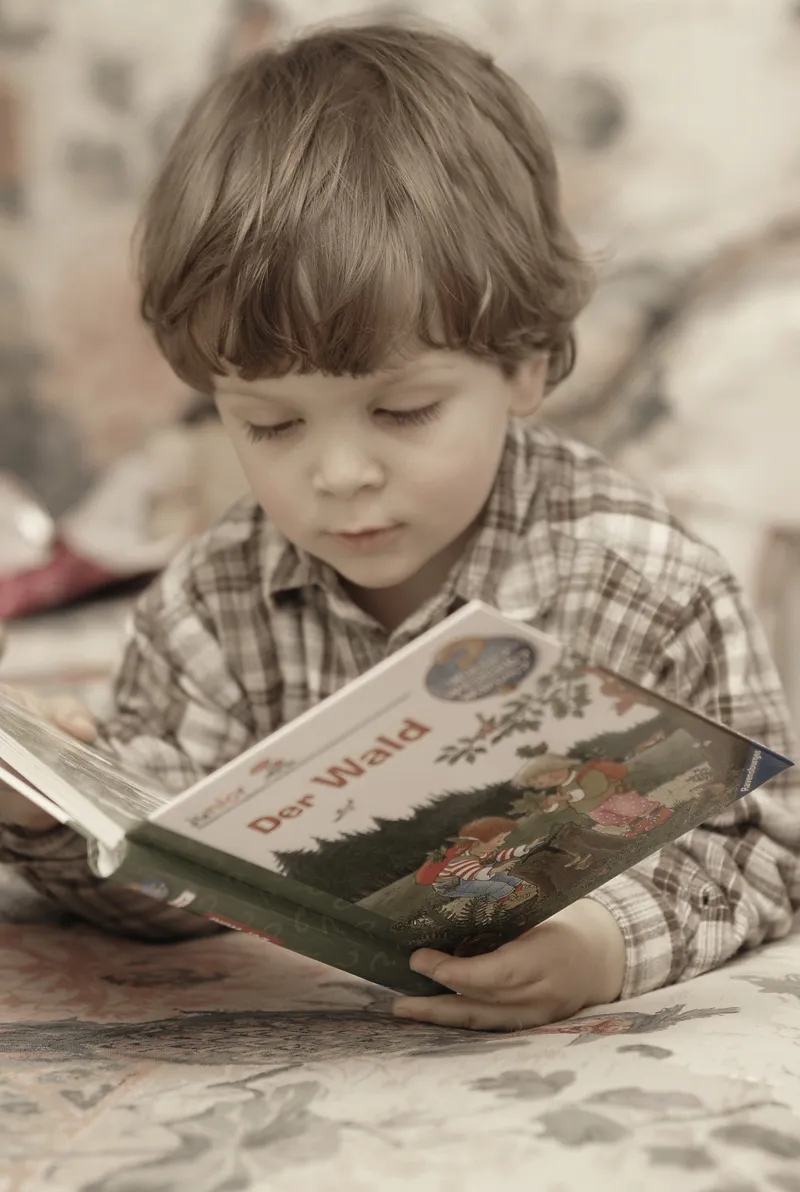
The little ones run, jump and climb, but don't always dare to jump or slide down again once they have climbed up somewhere ...
(Photo: Jens Brüggemann)
If you take them to the playground, they start to make friends by running along with other children to slide, climb, jump or swing together.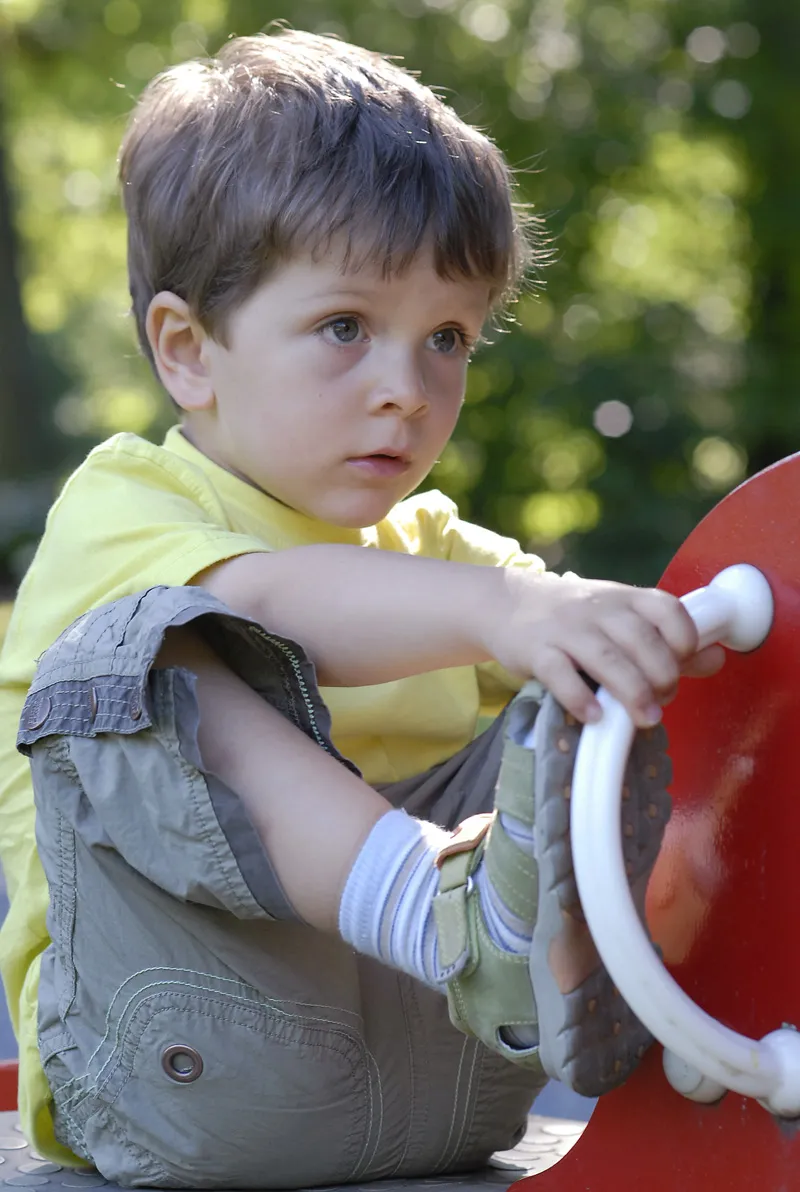
(Photo: Jens Brüggemann)
Kindergarten age
(3 - 5 years)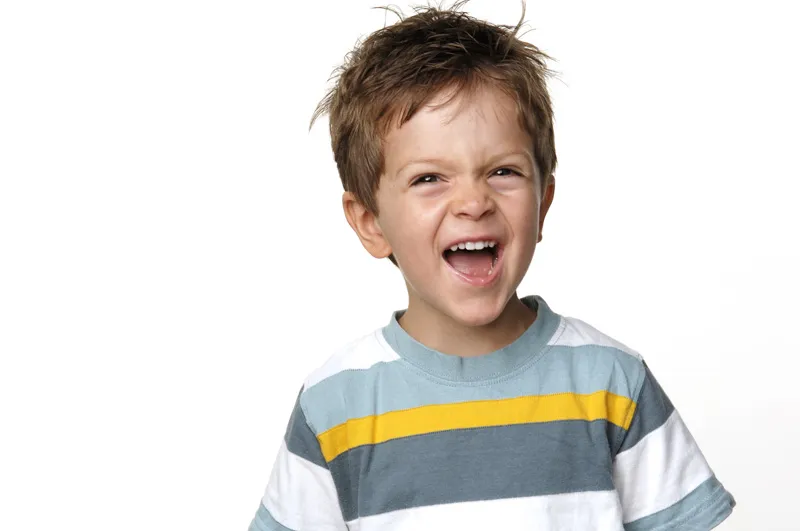
(Photo: Jens Brüggemann)
Children between the ages of three and four learn to run and jump well. They can throw a ball well and ride a tricycle, perhaps even a bicycle.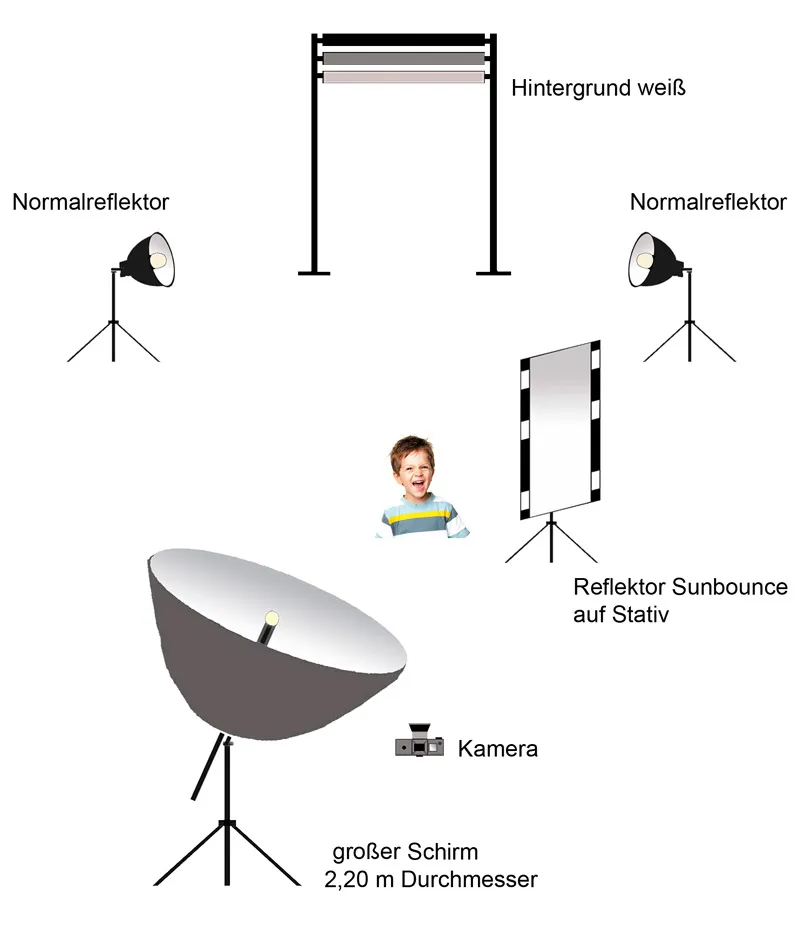
(Sketch: Jens Brüggemann)
They become more and more confident when climbing and their fear of heights disappears, but not for their parents ...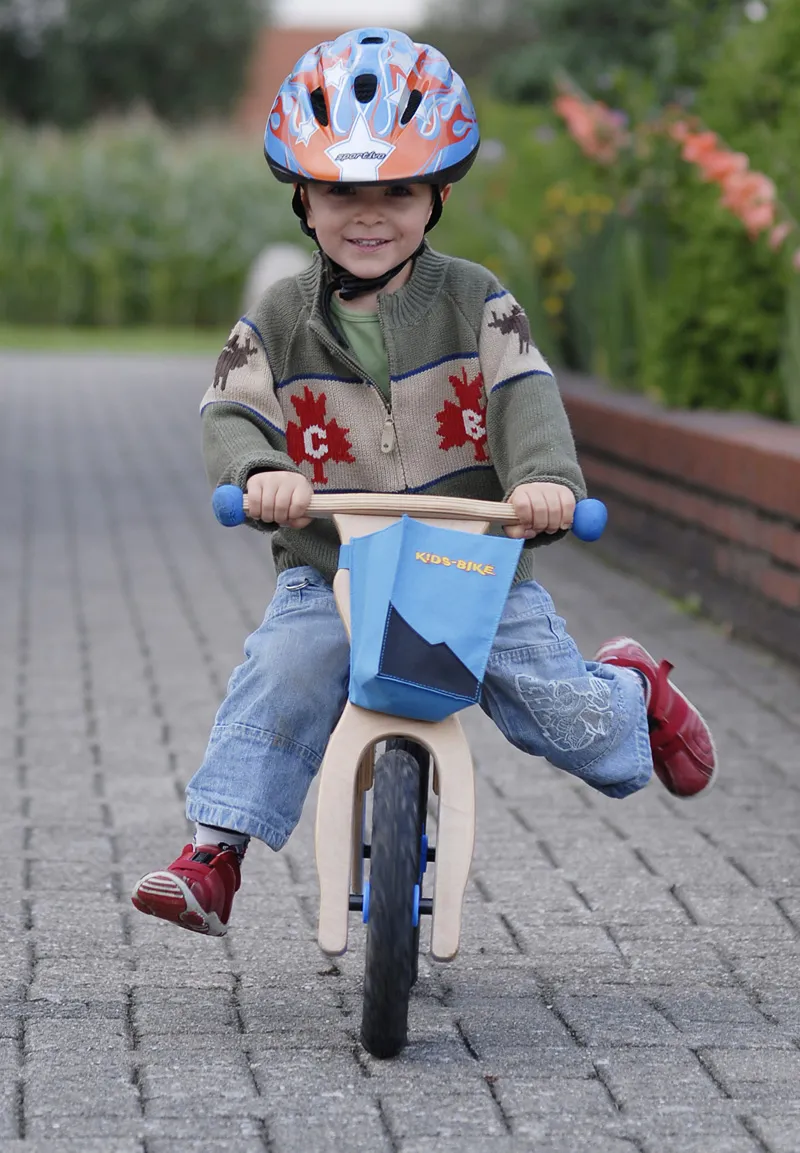
(Photo: Jens Brüggemann)
My son was four years old at the time of the following photo.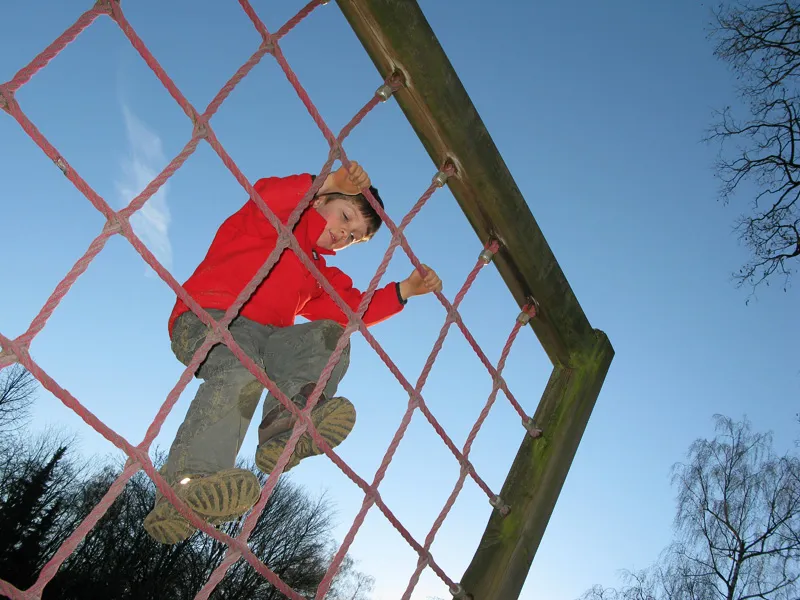
(Photo: Jens Brüggemann)
This photo was taken with the flash built into the camera (Canon G9). (Manual setting, 1/500 sec. at Blender 4.5).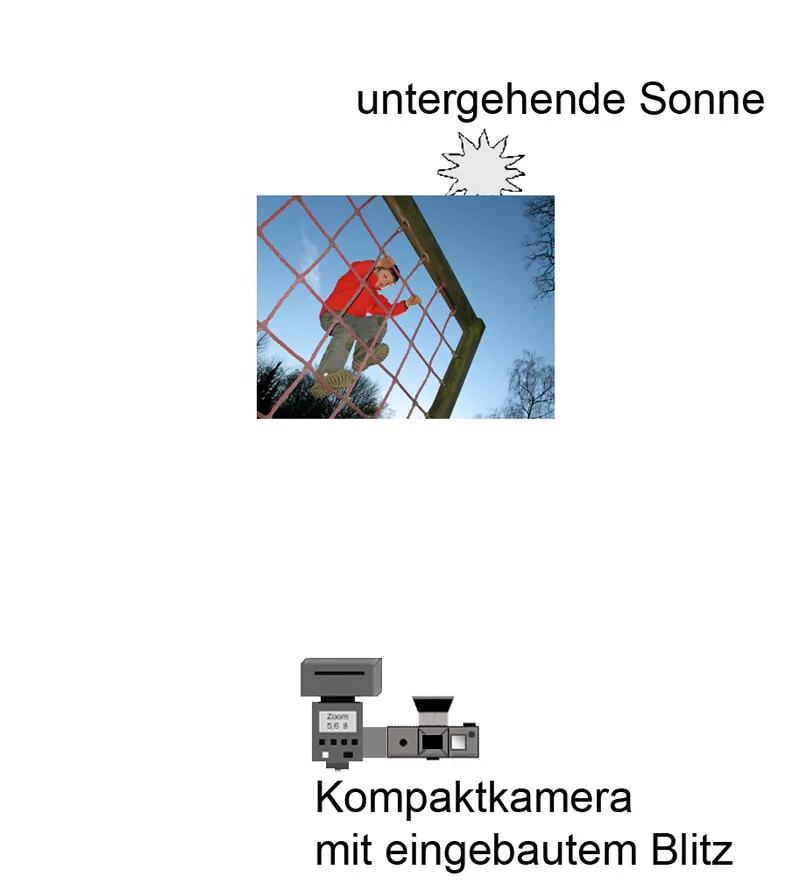
(Sketch: Jens Brüggemann)
At the age of four, the little ones speak confidently in full sentences and start conversations on their own. They sing and start to draw faces, can explain pictures and ask lots of questions. They also understand the content of television programs (as long as they have content ...). My son watched very little television back then, only the "laugh shows" such as "Mister Bean" and the funny home videos.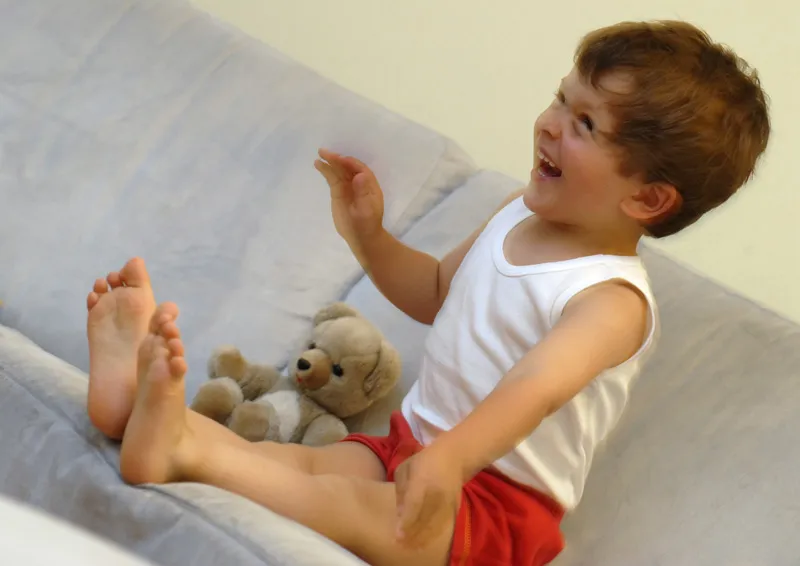
(Photo: Jens Brüggemann)
Children aged four become even more independent: they go to the toilet on their own, get dressed on their own and use a knife, fork and spoon.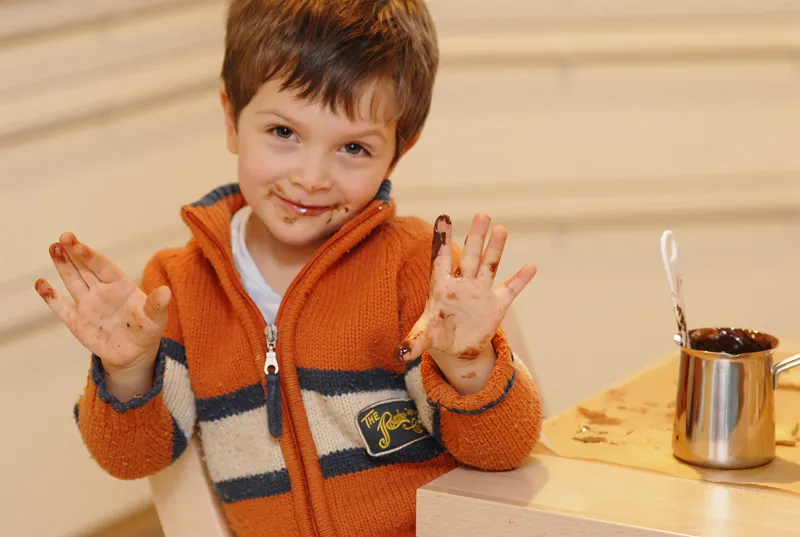
(Photo: Jens Brüggemann)
They like to play with other children and have a lot of imagination, which is why they often play role-playing games.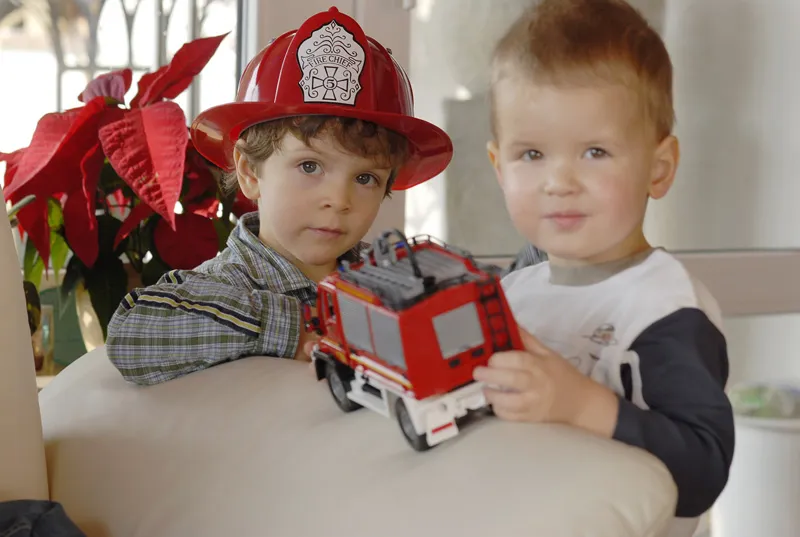
(Photo: Jens Brüggemann)
By the time they are five years old, they are able to recite nursery rhymes and sing songs. Bouncing, jumping, running and climbing become increasingly safe, and now even higher climbing frames or trees are no longer left out.
The visit to "climbing parks" can begin. For this photo, I chose a telephoto lens, which I used with a large Blender to blur the background (and thus make it calmer). (Nikon D3 with 2.0/200mm; ISO 2000; 1/640 sec. at aperture 4.0). (Photo: Jens Brüggemann)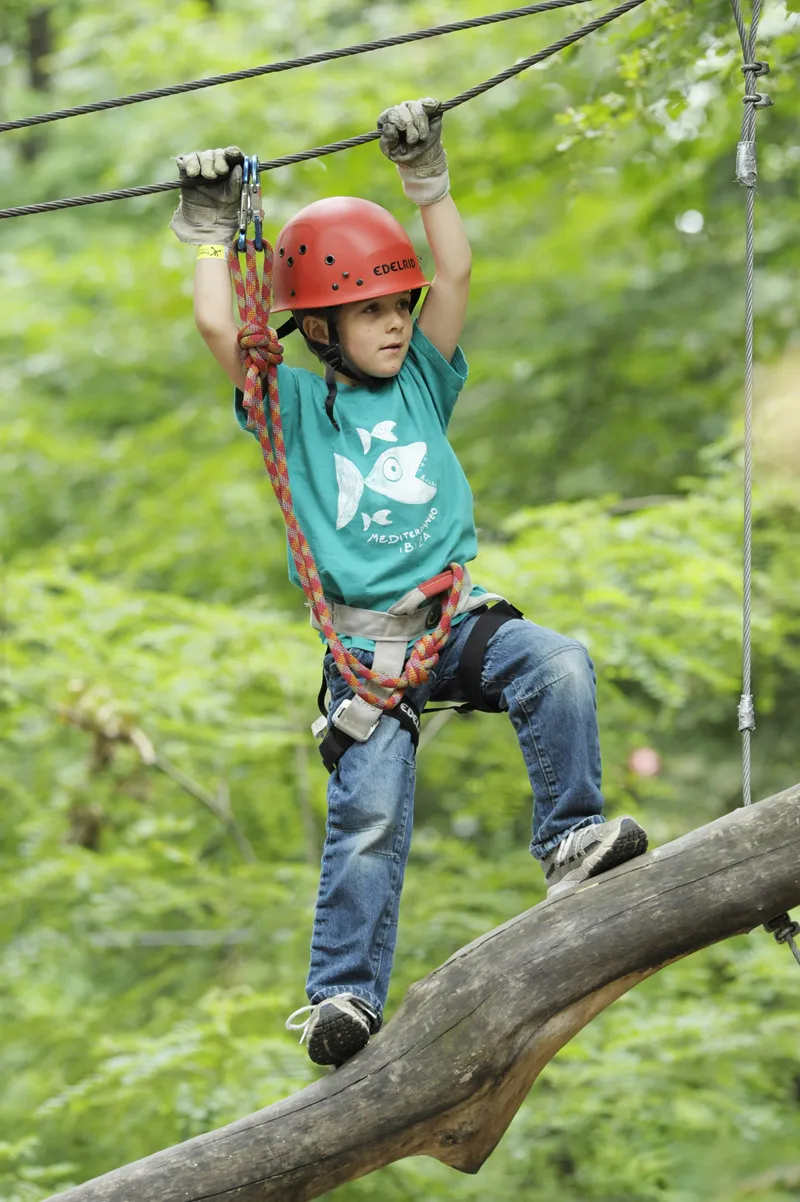
The simplest words and sometimes even short sentences are read at the age of five to six. Often the little ones already know all the letters, including the umlauts.
Some children can count to ten, others to one hundred. Some learn to write their name, as well as "mom", "dad", "grandma" and "grandpa". Pencils and scissors are held and used correctly. New skills and abilities are proudly learned, such as swimming ...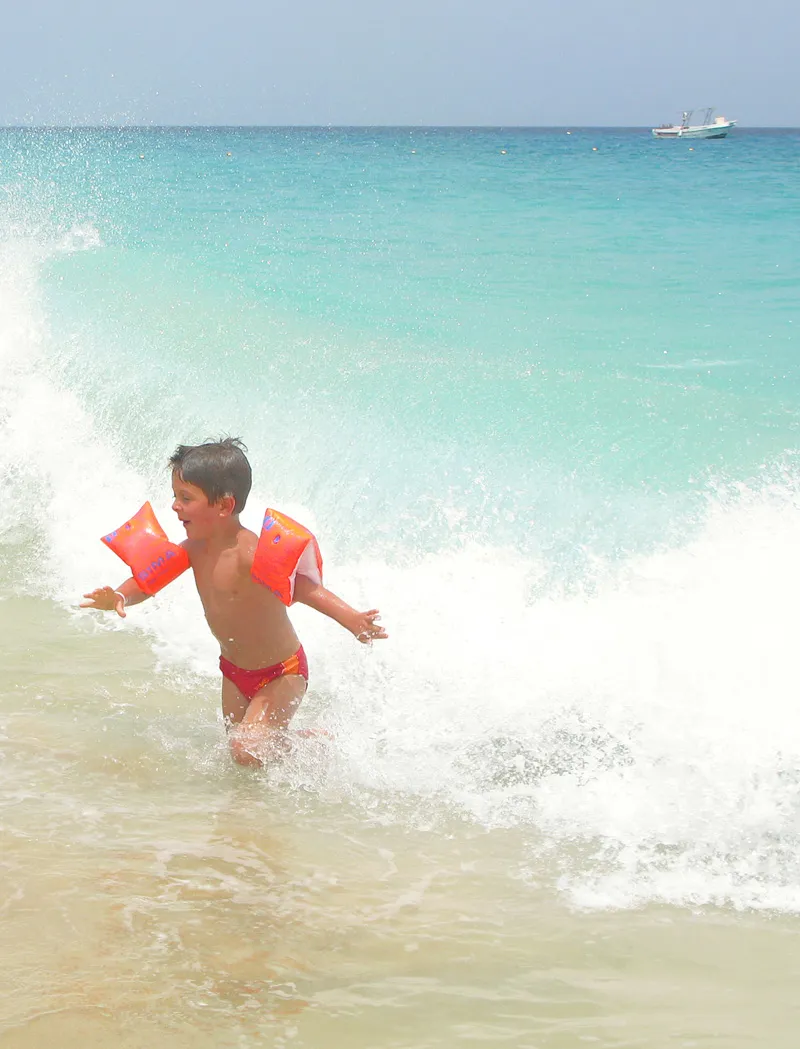
(Photo: Jens Brüggemann)
... or soccer. (Nikon D3 with 2.8/300mm; 800 ISO; 1/1000 sec. at Blender 6.3).
(Photo: Jens Brüggemann)
At this age, the little ones learn to occupy themselves, they also like to play on their own. My son even started to close the door to his nursery occasionally so that he could play alone undisturbed. It was a strange feeling the first time, I remember my wife and I looking at each other in shock.
Curiosity continues to drive the little ones to learn more and more; they are downright inquisitive and want to explore the adult world, which is why they continue to imitate their parents. It is not uncommon to have the impression of seeing yourself in the child. They hold a mirror up to us through their lives, and we discover ourselves in many of the things their offspring do.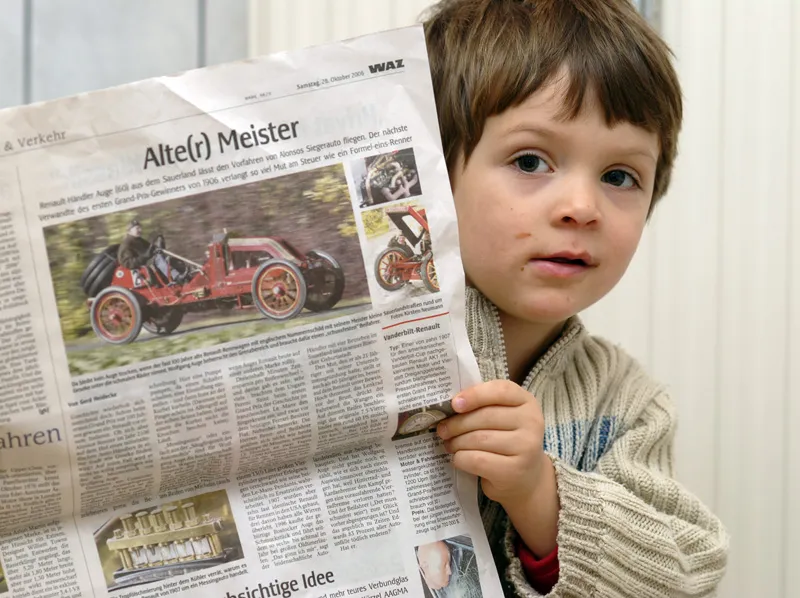
(Photo: Jens Brüggemann)
Schoolchildren
(from the age of 6)
By the time your son or daughter starts school, they will have already developed from a dependent newborn to an almost independent personality. It is now possible to have sensible conversations with your offspring, even if they are still children and occasionally behave extremely silly.
(Photo: Jens Brüggemann)
Their imagination is still almost limitless, which is noticeable in their play.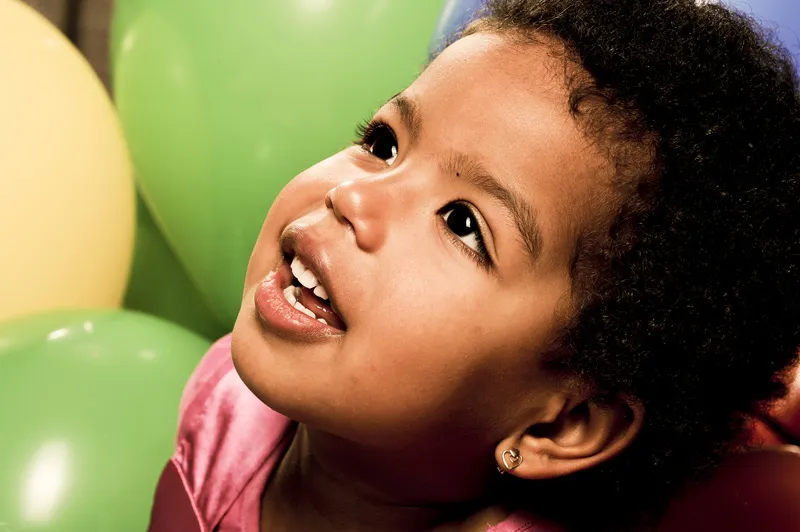
(Photo: Elli Bezensek)
You should definitely take a photo (or have one taken) when your child starts school! It's a very important day for your child, and you should show her or him that, for example with a nice big school bag and by having both spouses present at this event. The photo was taken with the Nikon D2X (equipped with 2.8/105mm) at ISO 200 and 1/250 sec. at Blender 2.8.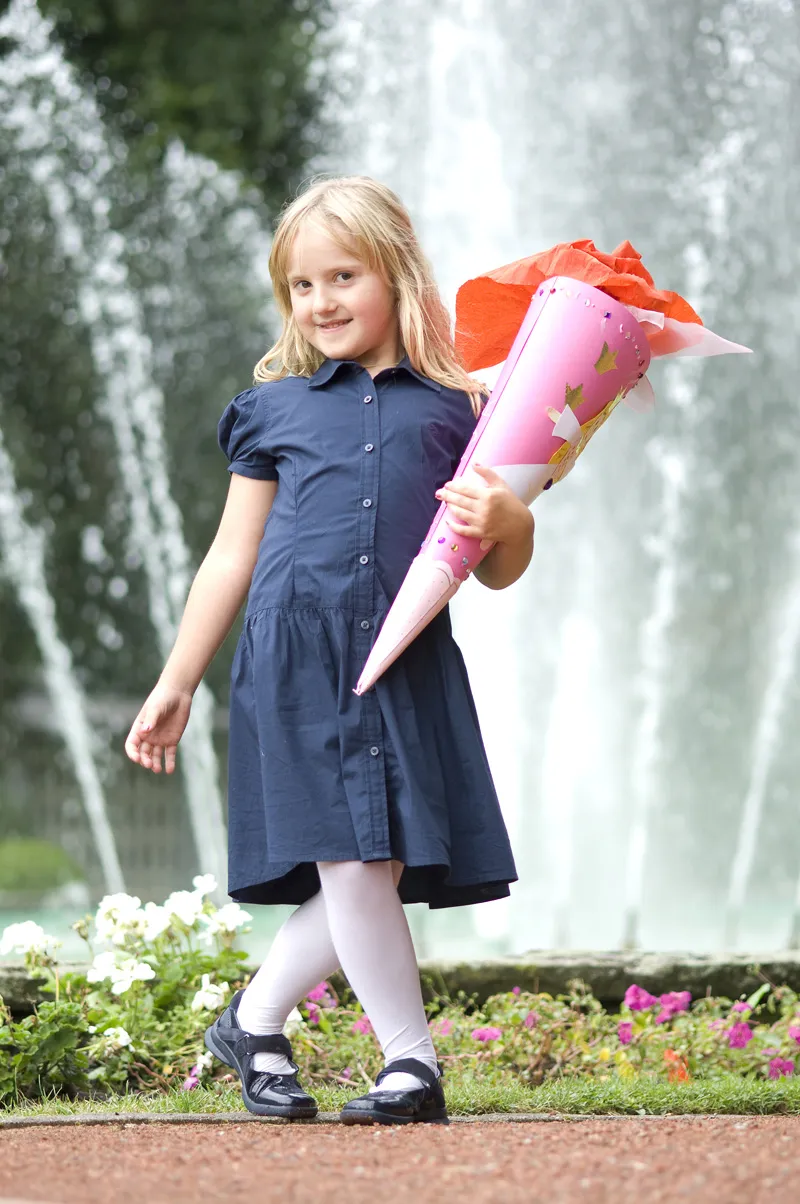
(Photo: Elli Bezensek)
If you have several children, don't miss the opportunity to take a photo of them all together. An excellent gift for the grandparents for Christmas! (Nikon D2X with 2.8/17-55mm at ISO 200 and 1/125 sec. at Blender 8).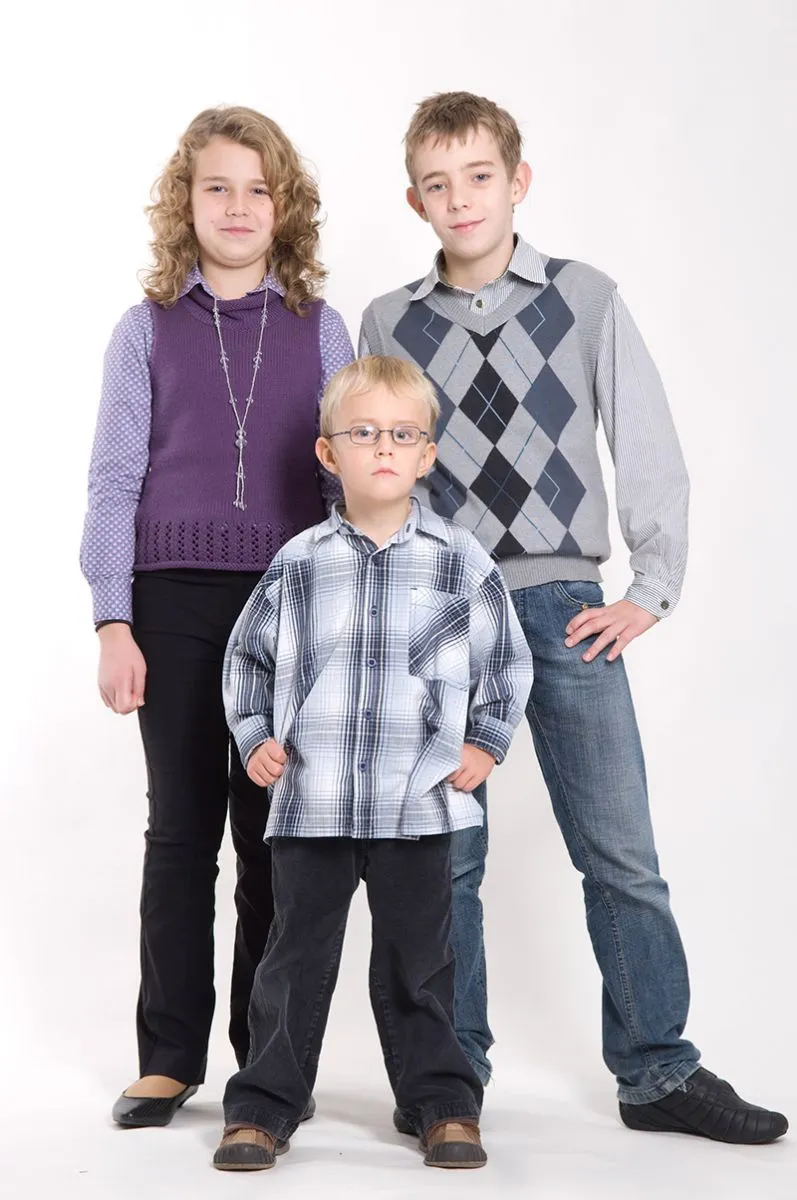
Photo: (Elli Bezensek)
At school age, the "little ones" (you can't call them that anymore!) become more and more independent. They join sports clubs, develop ambition and have friends they like to meet up with. They are happy when they bring home medals from sports tournaments and are annoyed when their team has lost again ... (Nikon D3 with 2.8/300mm at ISO 1250 and 1/1600 sec. at Blender 5.0).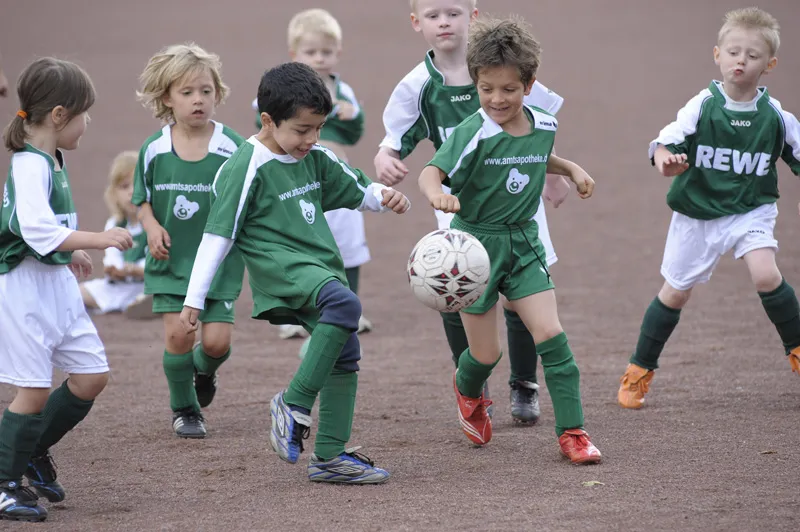
(Photo: Jens Brüggemann)
At an early school age, Lego becomes almost every child's favorite toy. From this age, children have enough patience and also the necessary dexterity to assemble the many small bricks according to instructions. The variety of Lego themes is now limitless, and adults also quickly take a liking to the small, colorful bricks, which can be used not only to build according to instructions, but also "freely".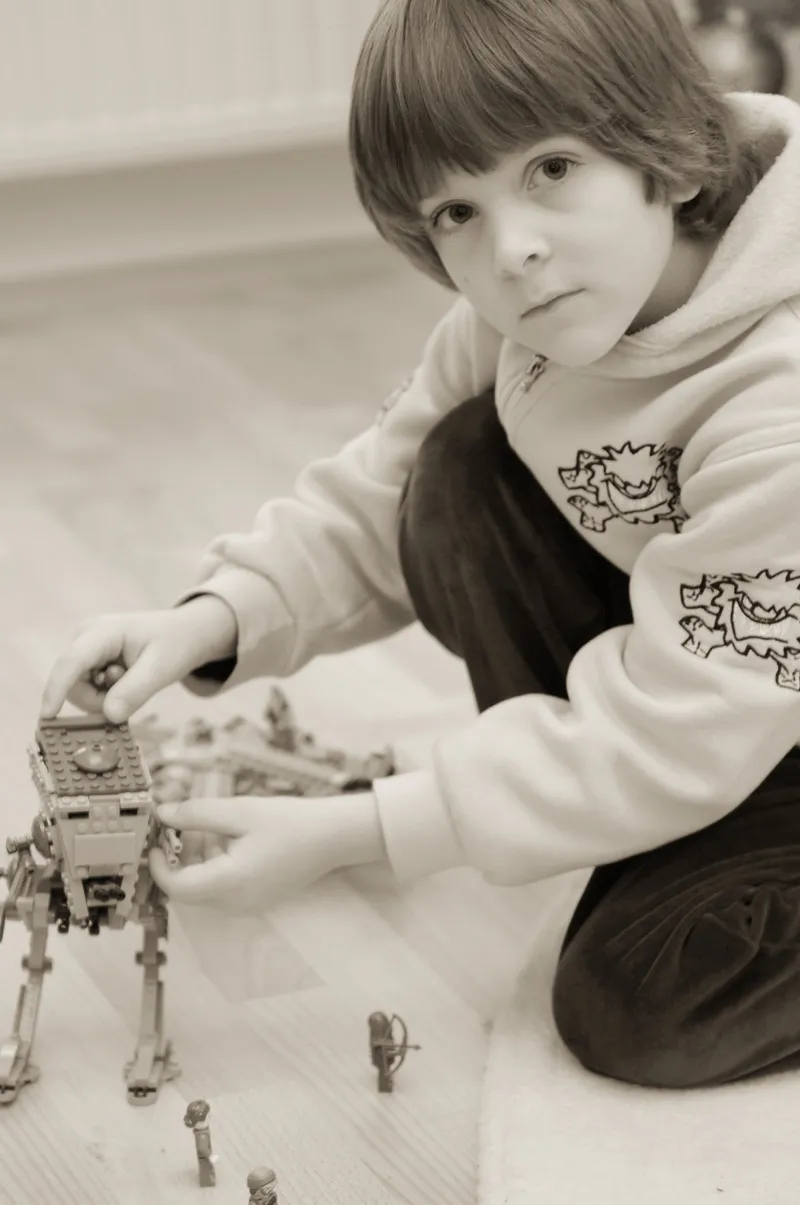
(Photo: Jens Brüggemann)
When your children reach school age, they will come up with more and more photo ideas. That's great!
Make use of your child's creativity! You will no longer be able to avoid letting your child borrow your camera to try out. But before you start sweating blood and water in fear of losing your favorite camera, it's better to give your child their own.
It doesn't have to be bought automatically, perhaps you have an old (previous) model that you can give to your son or daughter?
Teens and twens
As the children get older, the photos of them also change. Instead of snapshots of them playing with dolls or building blocks, posed photos will now be the order of the day, ...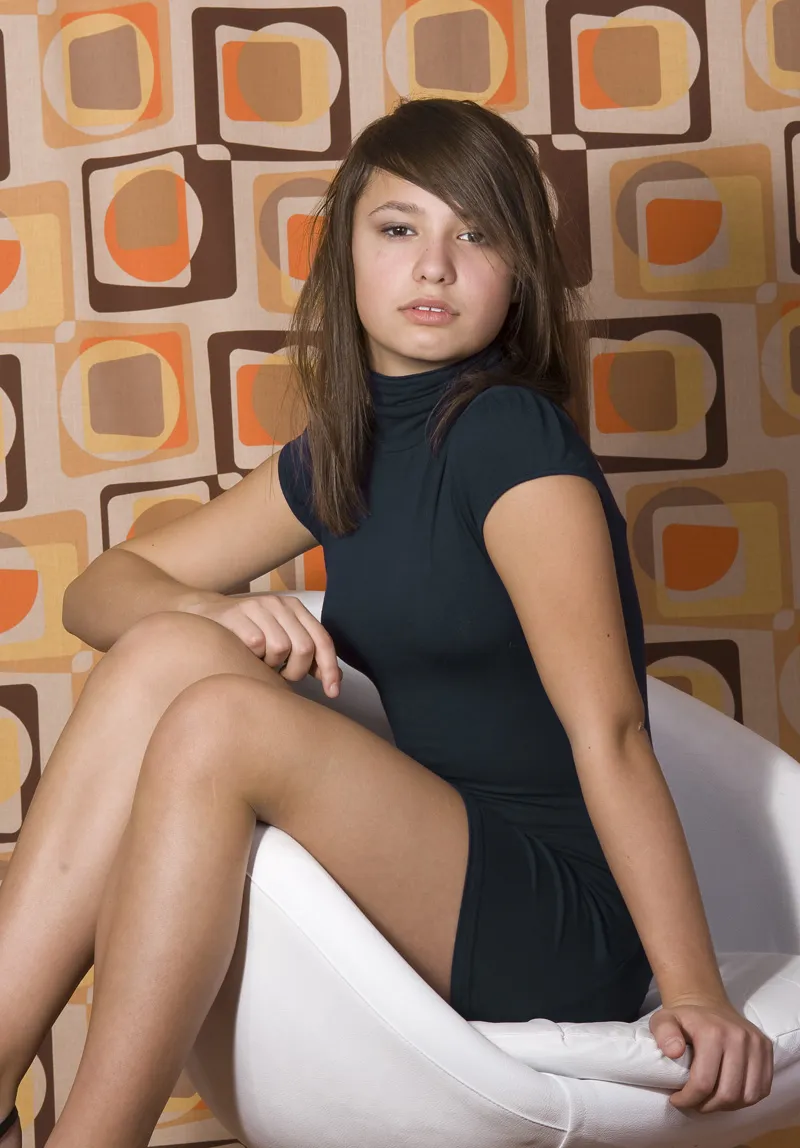
(Photo: Elli Bezensek)
... of the teenagers either in cool ...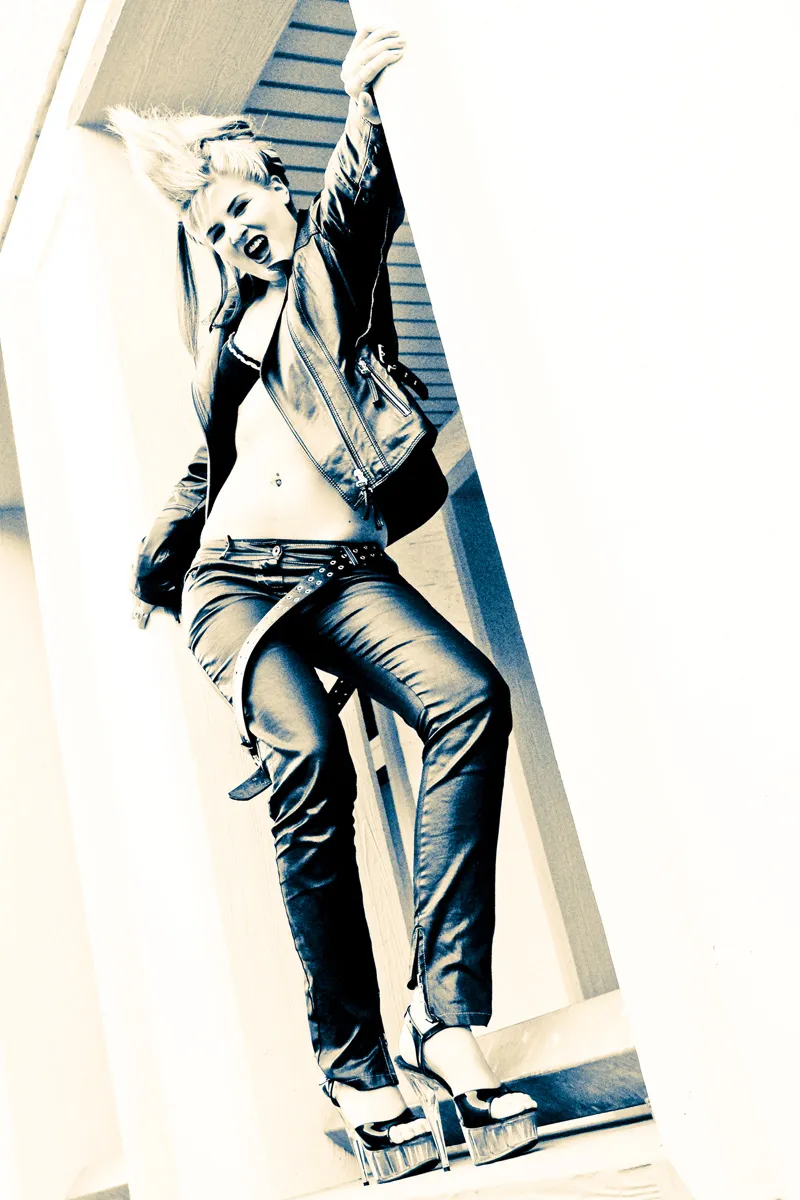
(Photo: Elli Bezensek)
... or in seductive poses.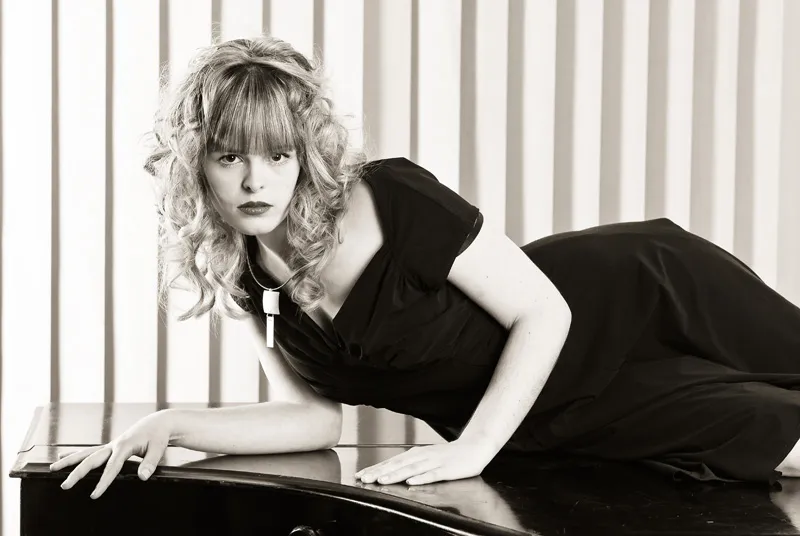
(Photo: Elli Bezensek)
Most girls wear make-up from their teenage years at the latest. If in doubt, it's better to apply a little more make-up because it usually looks less heavy in photos than "in the flesh".
If you use a professional make-up artist (or a make-up artist) for the shoot, they will take this to heart anyway. It is important that not only the face is made up, but that a transition is created at the neck/decolleté so that the model does not look like a "matchstick" (head made up dark, the rest white).
It's impressive what professional make-up can do for a "normal" girl ...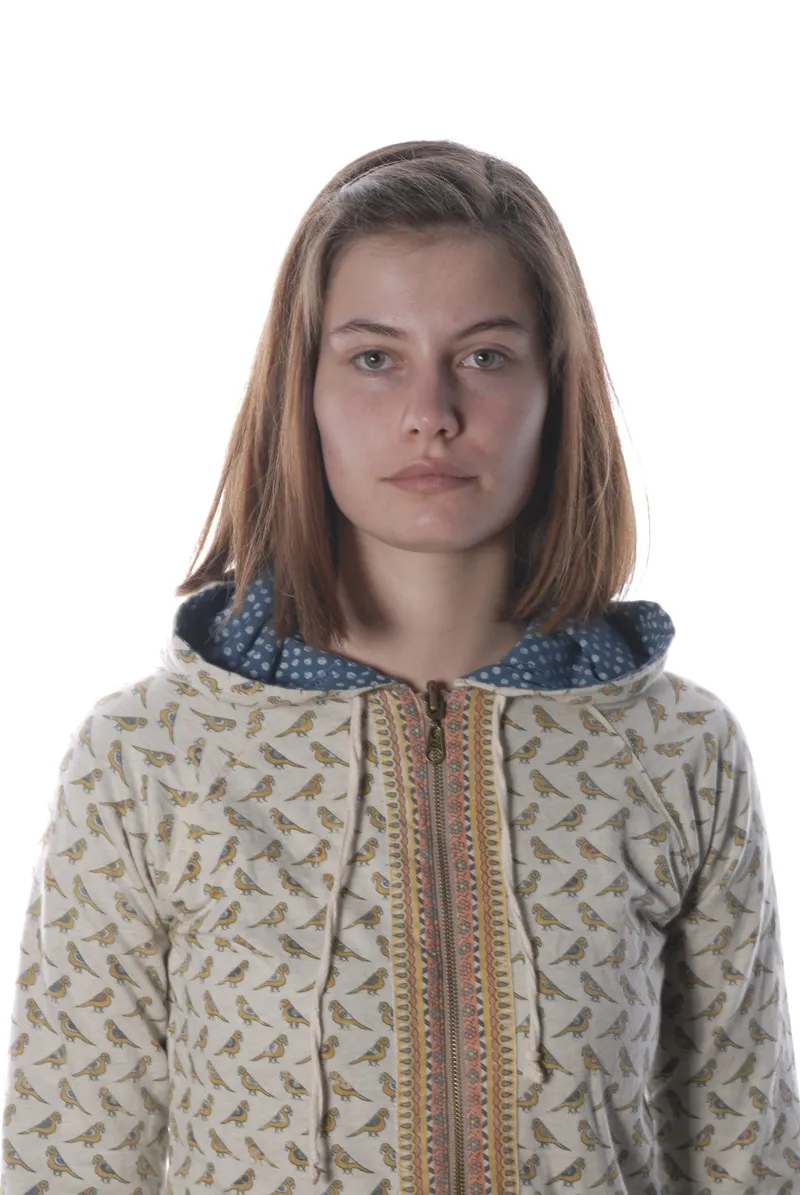
(Photo: Elli Bezensek)
... as these before and after photos by the Paderborn photographer prove: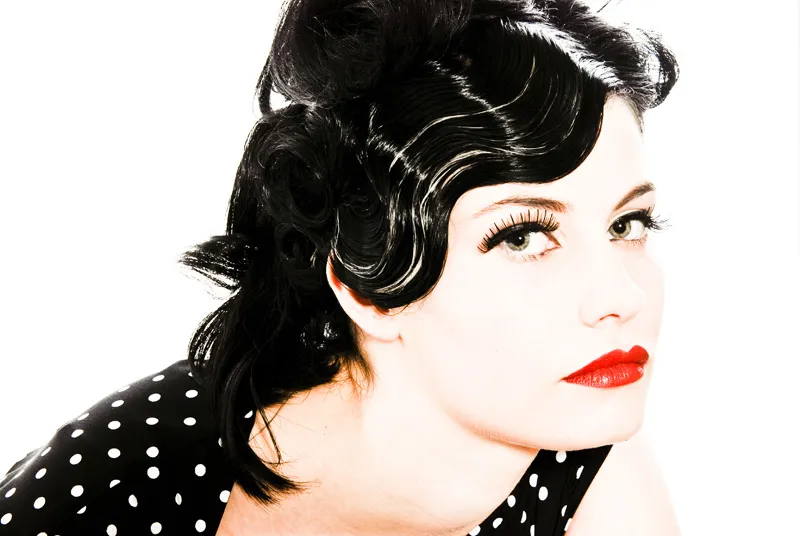
(Photo: Elli Bezensek)
Here are photos of another model, also taken on the same day, once "normal" ...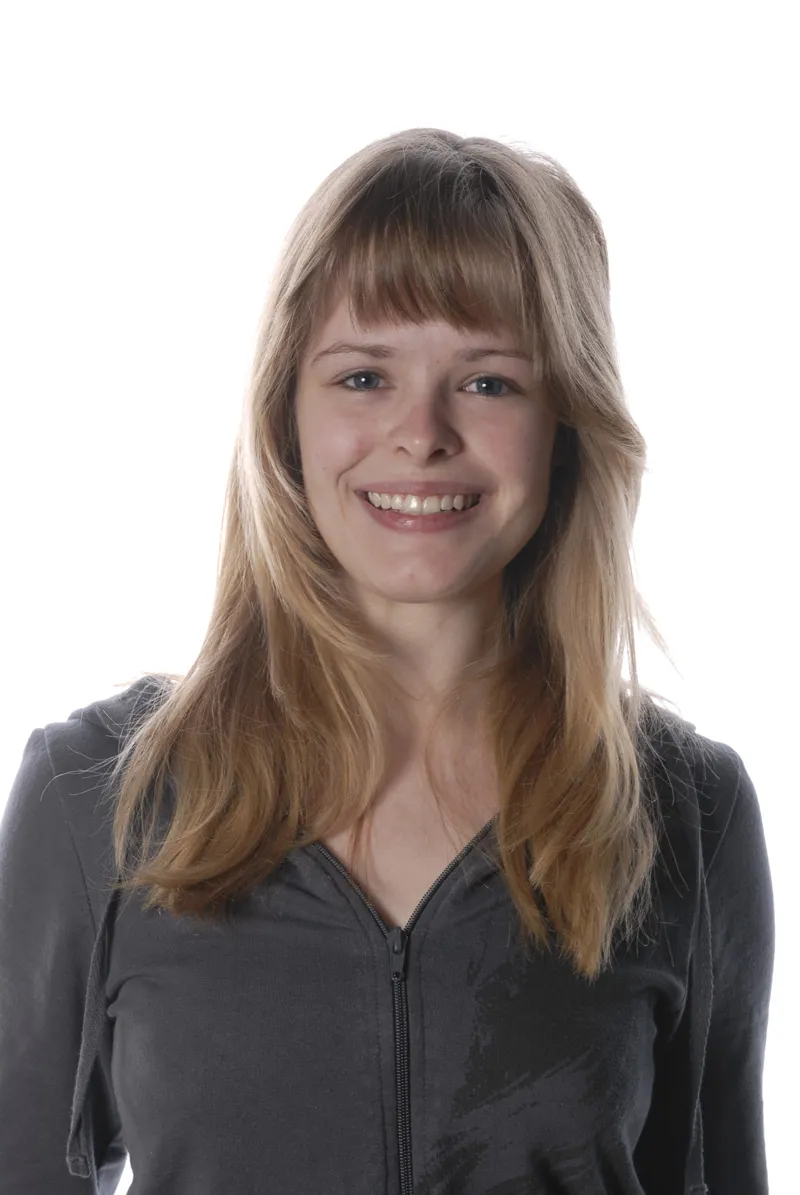
(Photo: Elli Bezensek)
...and once after a professional make-up: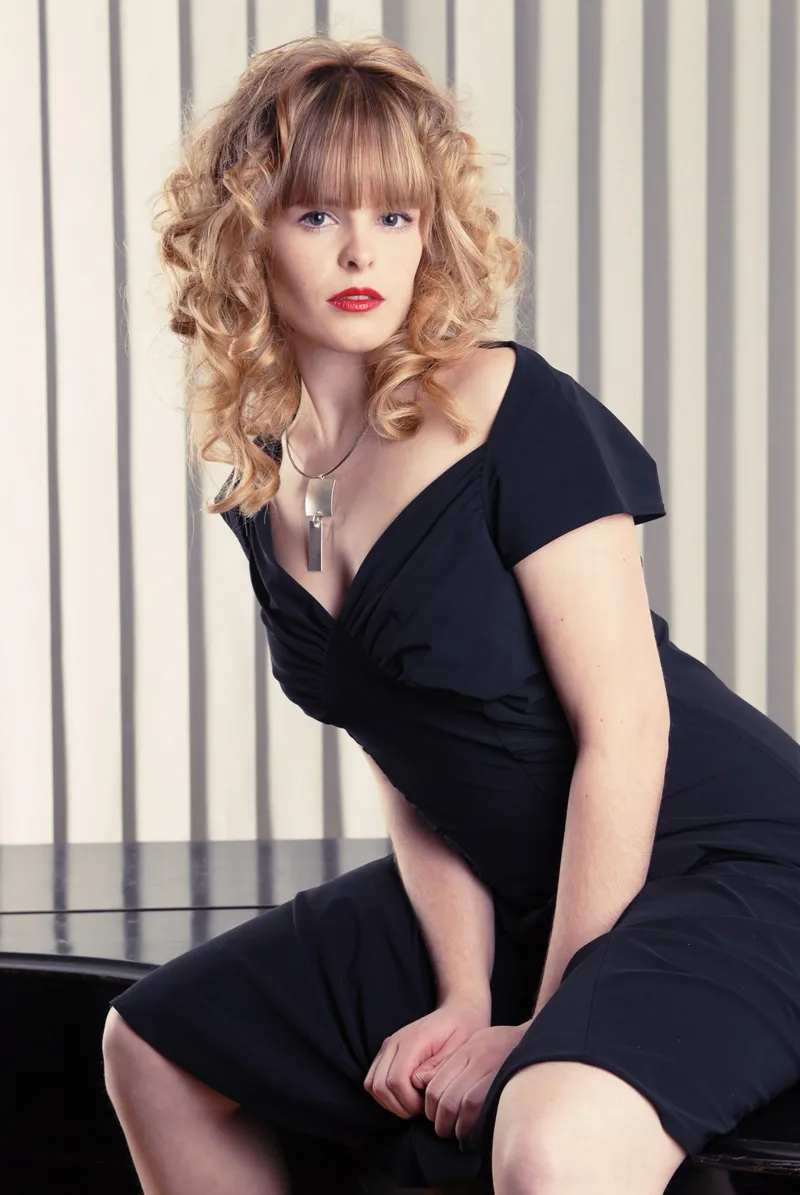
(Photo: Elli Bezensek)
And the "punk" also turns out, after make-up removal, ...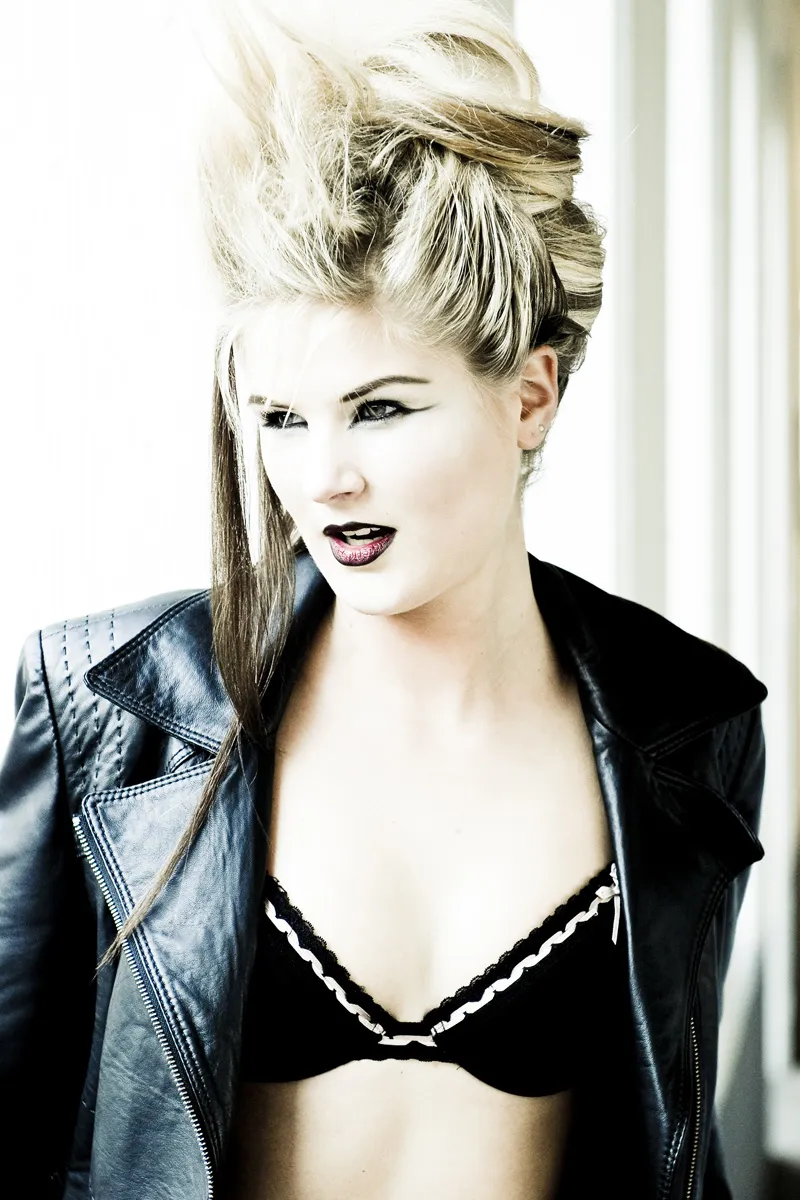
(Photo: Elli Bezensek)
...as a normal girl "from next door" (Nikon D200 with 2.8/24-70mm; at ISO 320; 1/60 sec. at aperture 3.5 (1st photo) and aperture 11 (2nd photo)):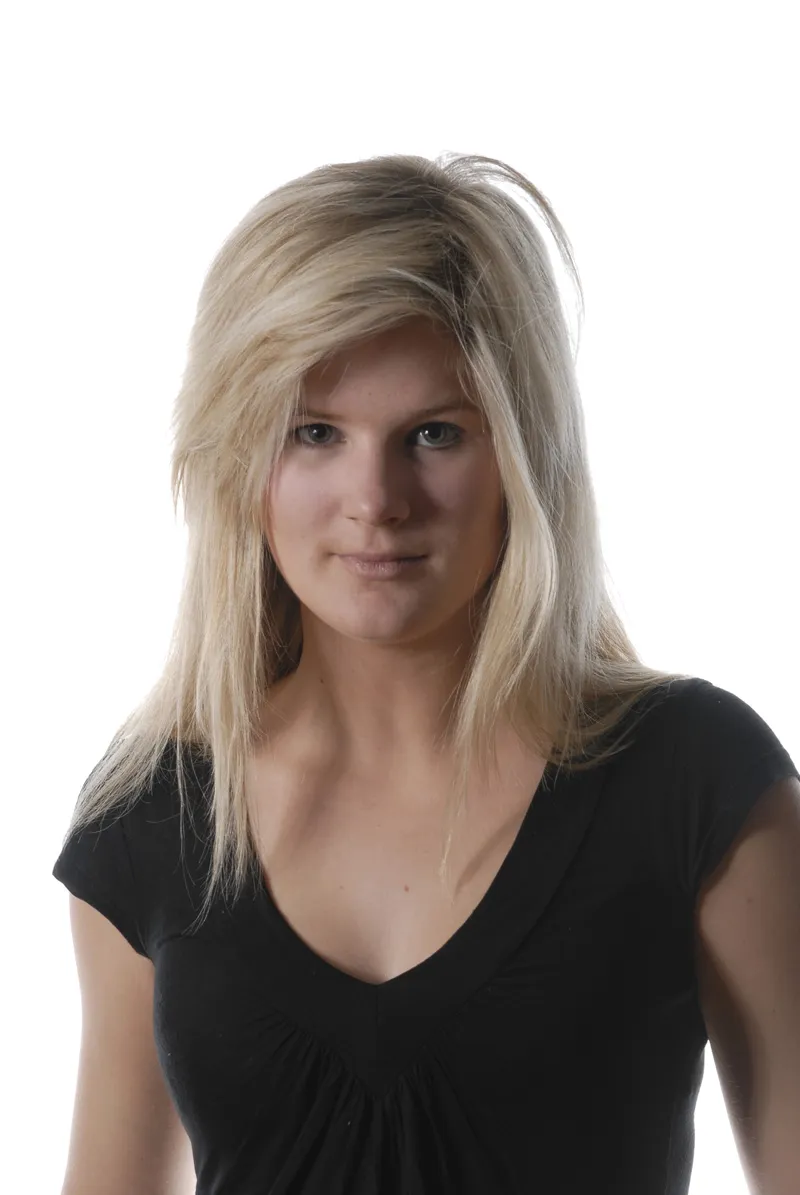
(Photo: Elli Bezensek)
Even if many teenagers won't admit it, the No. 1 motive for photos at this stage of life will be the search for a partner; closely followed by motive No. 2: photos as a special gift for the new partner. In this case, the photos can be "weird" and pop-colored so that they look "cool". These colors can be achieved in post-processing using an image editing program by changing the color saturation, manipulating gradation curves, playing with the color balance, adjusting the selective color correction, or choosing one of the many other options, depending on what the program provides and what you are most comfortable with. (Photo: Elli Bezensek)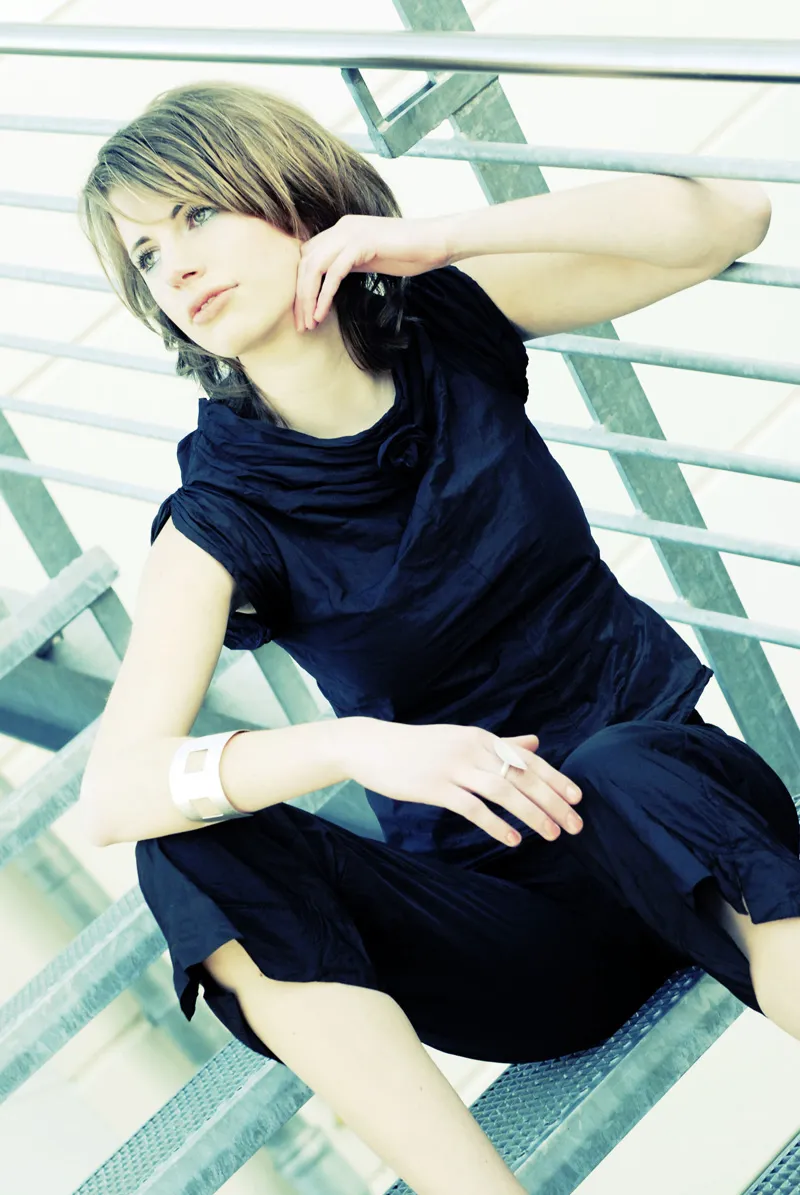
But classic black and white is also "in" again among teenagers. The photo was taken with the Nikon D200 in conjunction with the 2.8/24-70mm at ISO 100. 1/80 sec. at Blender 7.1.
(Photo: Elli Bezensek)
And if the photos lead to the desired success (in the search for a partner), you can then take couple photos of your model and his or her new girlfriend or boyfriend a little later ...!
The Paderborn photographer created a very nice composition for an engagement card of her brother and his fiancée. This collage shows the relaxed cheerfulness with which the young people are approaching the next stage of their lives together.
(Photo: Elli Bezensek)
The two have been married since 2007. And who knows? Perhaps life will soon come full circle again and they will have their first baby, of which you will then be able to take the first professional photos ...?
